The AIR³ XCT add-on enhances the functionality of XCTrack.
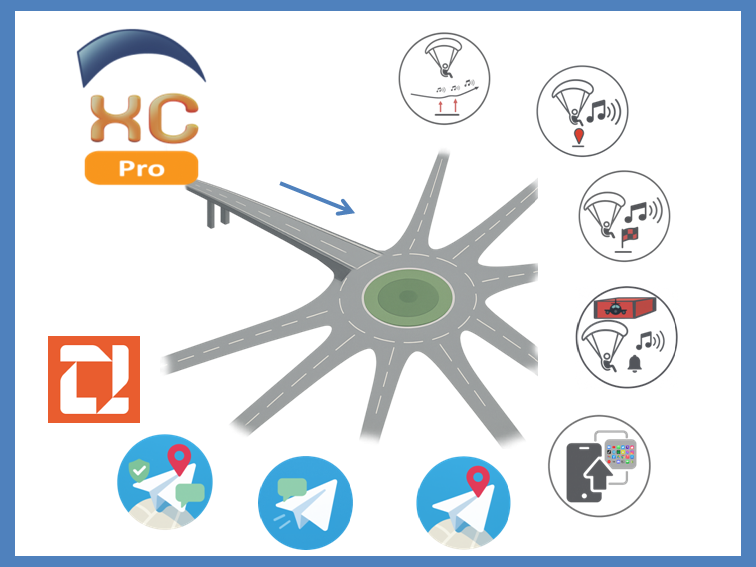
One of the AIR³ XCT add-on’s key features is its instant lift detection, which is based on accelerometers, as well as its special handling of weak lifts. The vario sound is produced by combining data from the pressure sensor and the accelerometer. This allows pilots to identify the start of lift immediately, recognise weak lift zones more easily and enjoy a clear vario sound when reaching higher vertical speeds.
Events generated by XCTrack are caught by the AIR³ XCT add-on, which then applies the defined task, based on combination rows.
Each combination row includes a trigger event and the task defined by the user.
There are different types of event: Take-off, landing, crossing a turnpoint, crossing the start or the end of speed section during competition, clicking on a specific button (remote Bluetooth command or device button), clicking on a specific widget, warnings related to proximity of an airspace zone, etc.
The following types of task can be defined: Start the instant vario, Stop the instant vario, Zello PTT, play a specific sound, send a Telegram message to a group, send my Telegram position to a group, Safe landing reporting (Send my Telegram position and a predefined message if I do not validate the Safe landing reporting confirmation), launch a specific app in the foreground or background.
Technical considerations: Use the AIR³ Upgrader to ensure that you have the latest versions of XCTrack (version 0.9.12.3.11 or higher) and AIR³ Manager installed. Otherwise, the AIR³ XCT add-on will not work as intended. While AIR³ Manager is not necessary for the AIR³ XCT Add-on to work, it does allow you to set an automatic launch on boot, so that the setup will work automatically each time without you having to worry about starting it manually.
If you have read these instructions and are having trouble getting the AIR³ XCT add-on to work properly, check this FAQ.
Combination rows
In the main screen, you combine a trigger event with a task. This is what we will call a combination row.
With an AIR³, you can add as many combination rows as you want. This app can be used with any other Android device but it will then limited to one combination row. For example, with a regular phone, you can use a BT remote button to communicate through Zello with XCTrack running in the foreground (see below more details how to use Zello) or you can use the Safe Landing Reporting feature to ensure that people are notified if you do not land safely.
When you open the app, the first thing you will see is the different groups. Vario, Telegram, Zello, App Launch and Play Sound. The combination rows will be sorted according to group. In other words, combination rows related to Telegram will be in the Telegram group, those related to Vario will be in the Vario group, and so on. To create a new combination row, first click on the relevant group, then click on the ‘+’ sign. To return to the main screen, click on the arrow in the top left or click the ‘Main Screen’ button.
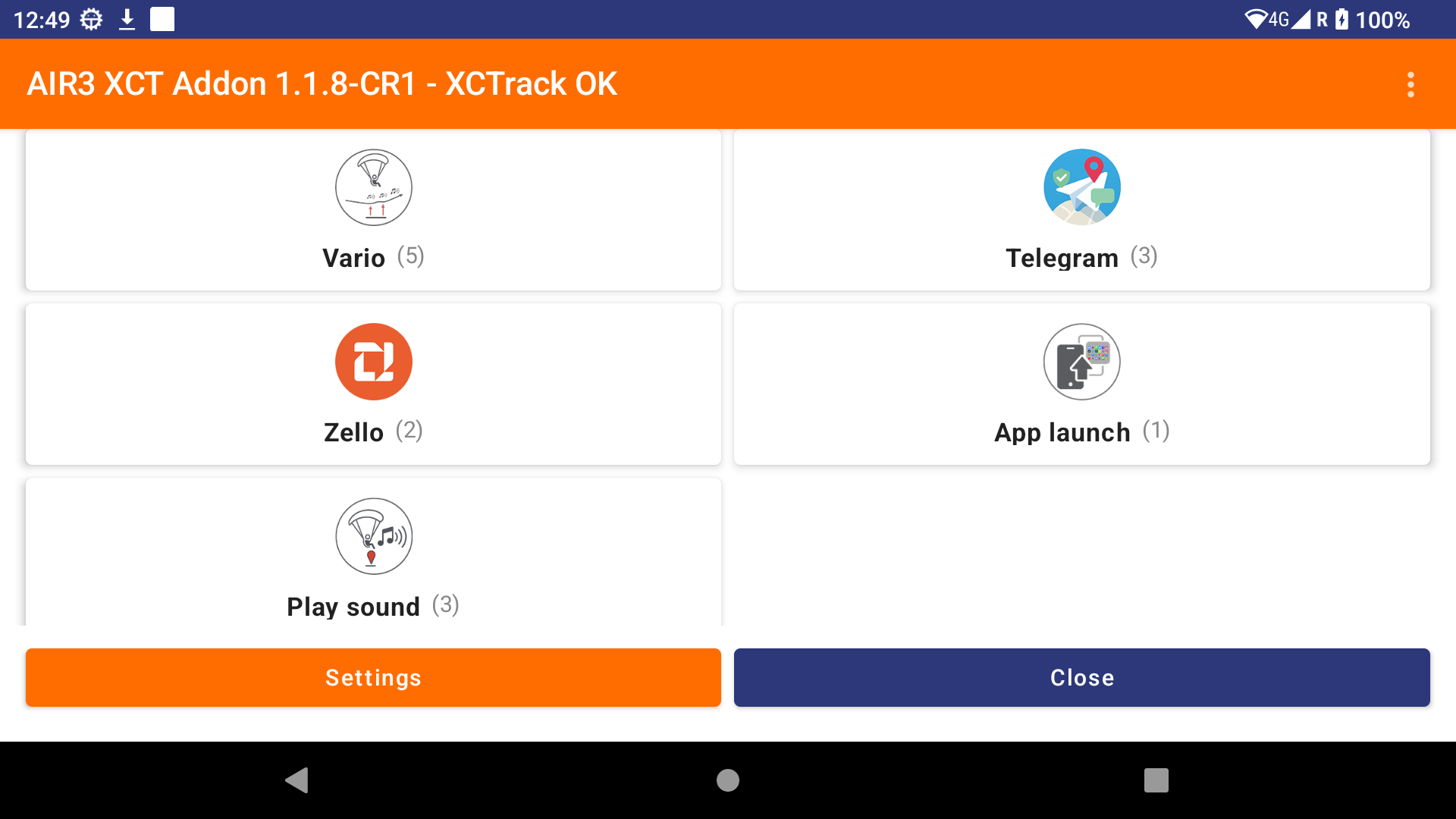
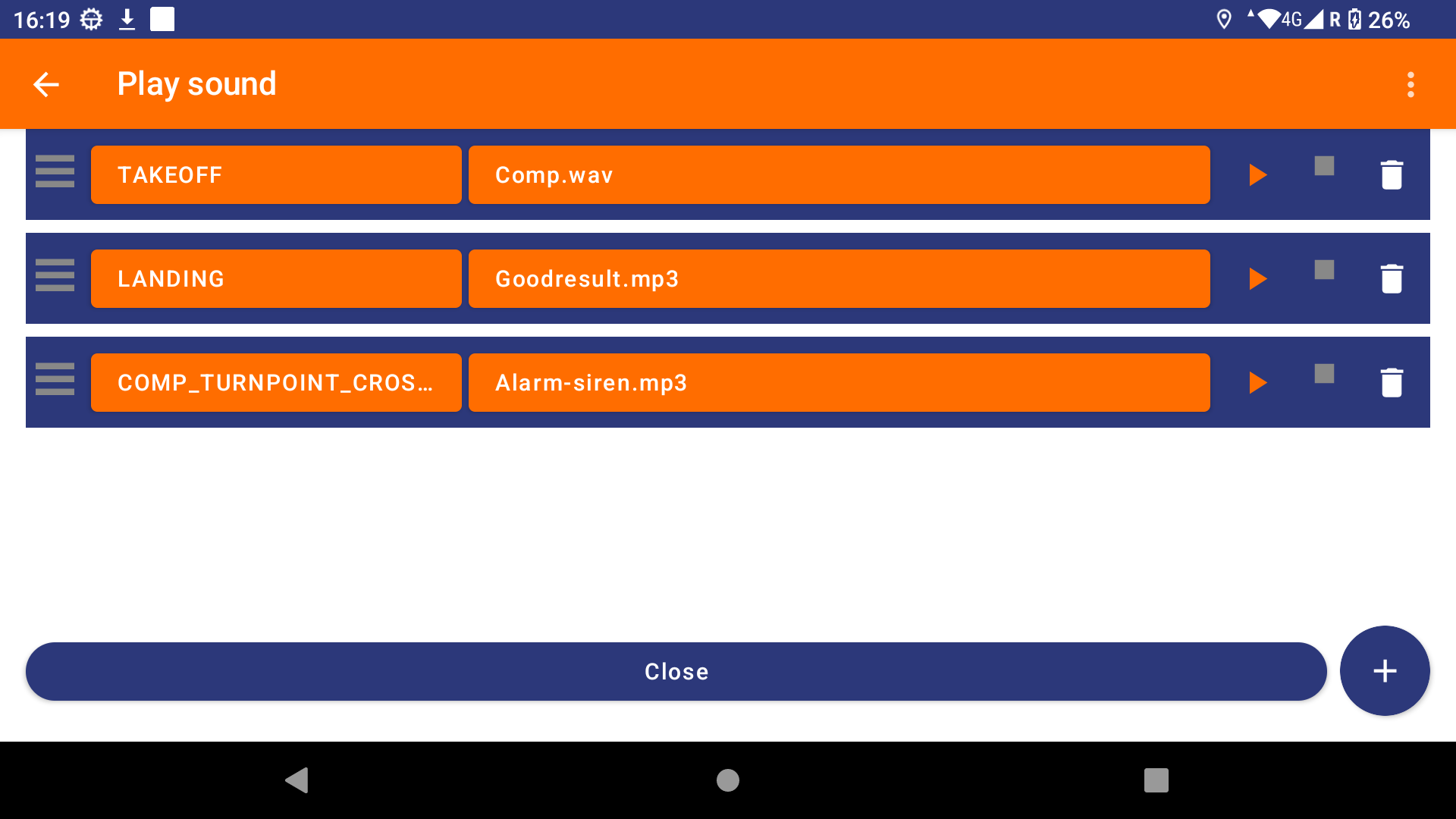
One of the AIR³ XCT add-on’s key features is its instant lift detection, which is based on accelerometers, as well as its special handling of weak lift detection. The vario sound is produced by combining data from the pressure sensor and the accelerometer. This allows pilots to identify the start of lift immediately, recognise weak lift zones more easily and enjoy a clear vario sound when reaching higher vertical speeds.
Combination rows can be created automatically by enabling features. For example, enabling the Instant Lift and Vario Sound will create two new combination rows: one to start the instant vario upon takeoff and one to stop it upon landing. The same thing will happen with Zello. Enabling Zello will create two combination rows: one with an XCTrack event called ‘Zello’ to activate the Zello PTT feature, and one with the XCTrack button intent for the same purpose, in case you would prefer to use a hardware button instead of, or in addition to, a widget on the screen.
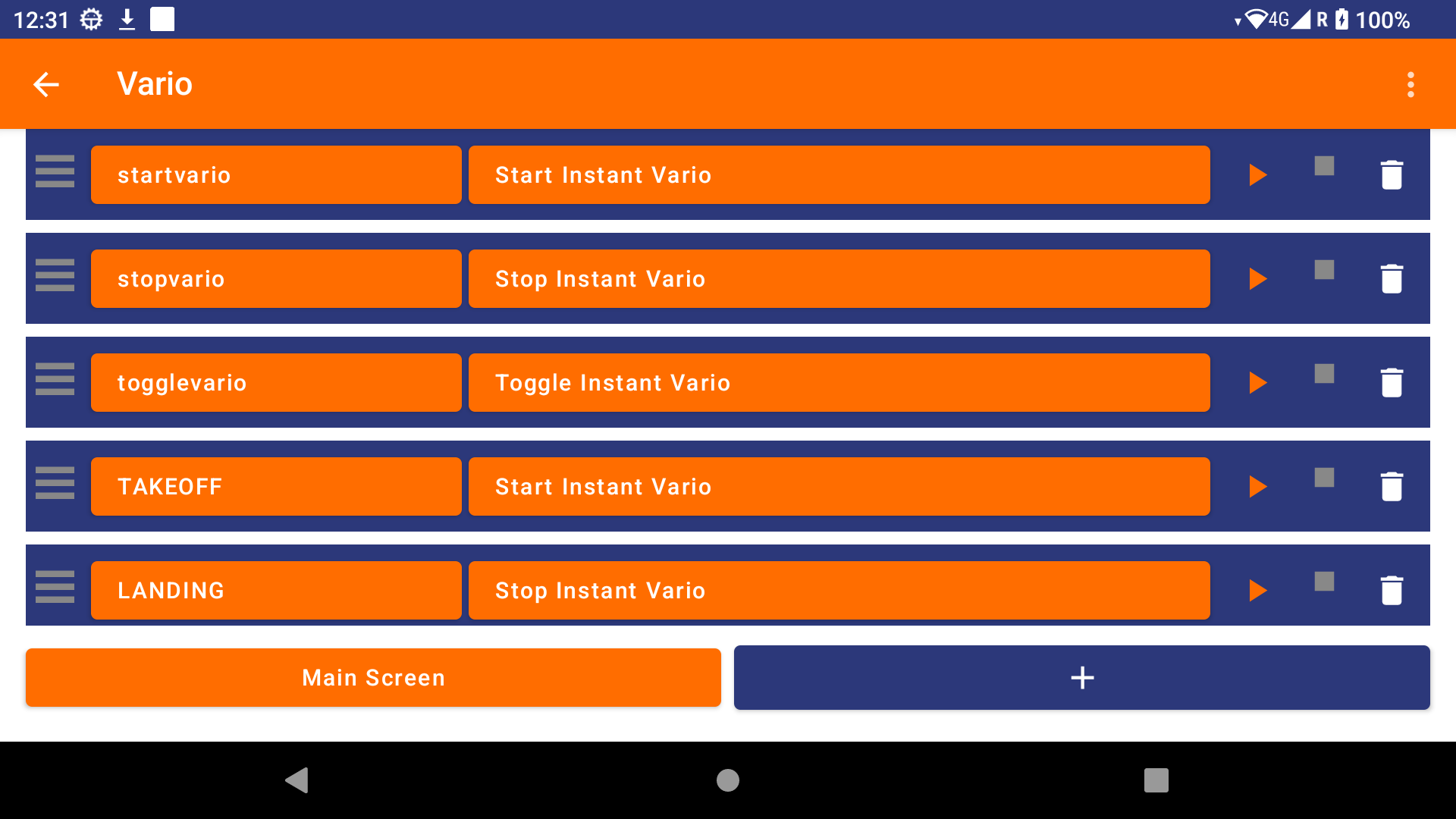
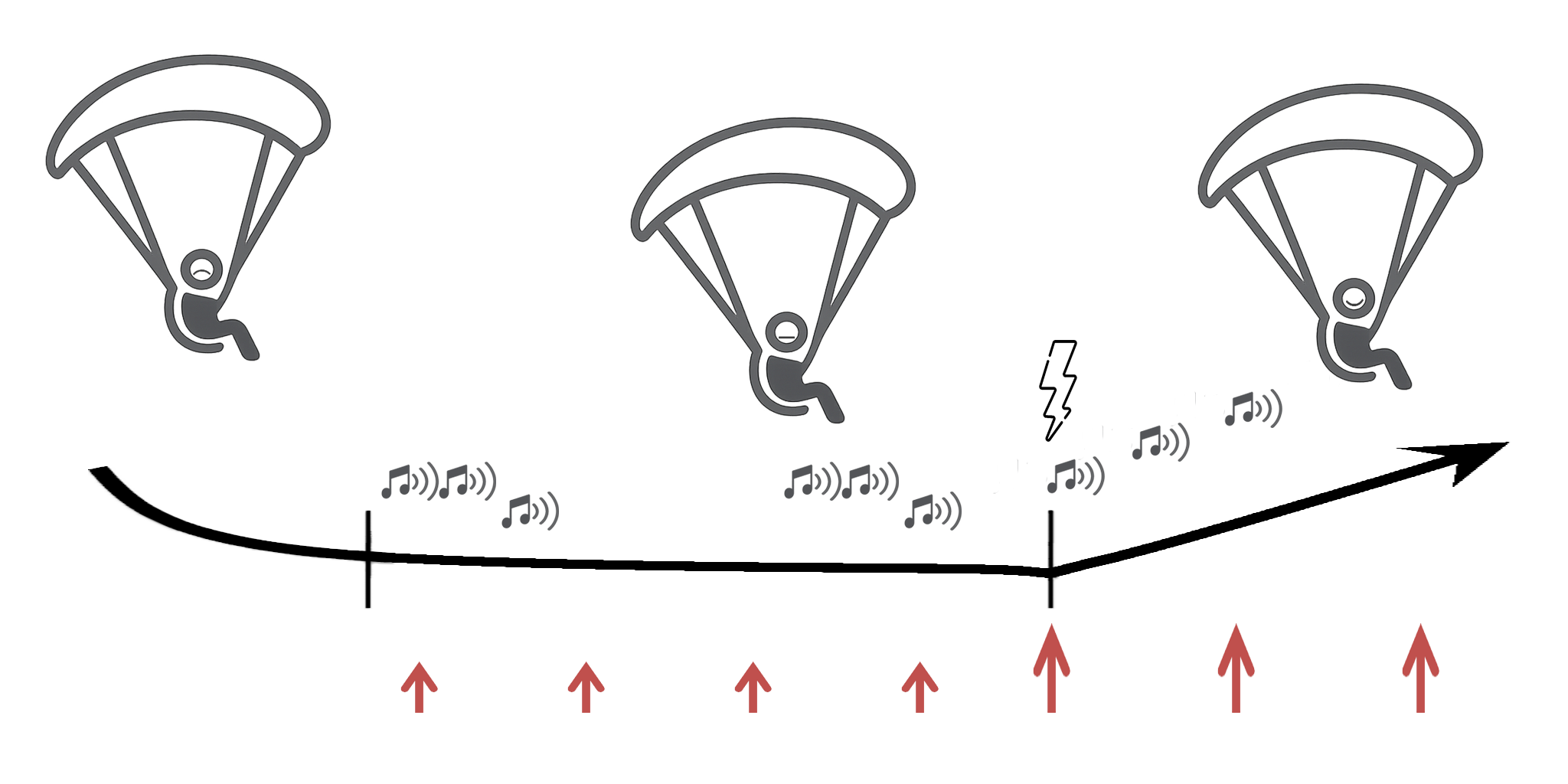
Instant lift detection, weak lift and vario sound
One of the AIR³ XCT add-on’s key features is its instant lift detection, which is based on accelerometers, as well as its special handling of weak lifts. The vario sound is produced by combining data from the pressure sensor and the accelerometer. This allows pilots to identify the start of lift immediately, recognise weak lift zones more easily and enjoy a clear vario sound when reaching higher vertical speeds.
How to use the new acoustic vario with Weak Lift and Instant Lift features ? Check this FAQ.
To use this feature, go to Settings > Instant Lift and vario sound and enable the tickbox “Enable Instant Lift and Vario Sound”.

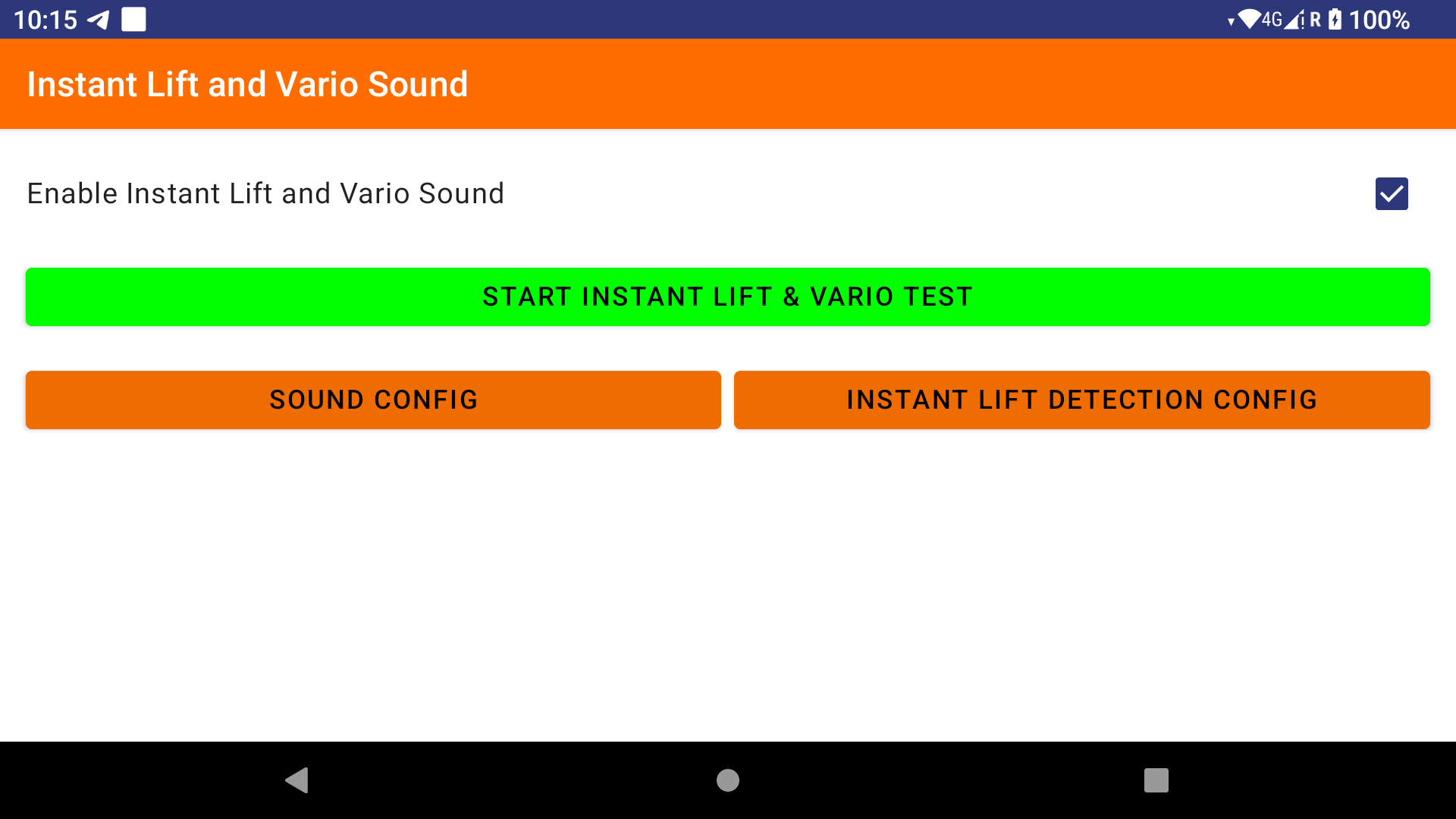
Enabling Instant Lift and Vario Sound creates new combination rows: one that is triggered by XCTrack when taking off to start the instant vario, and one that is triggered by XCTrack when landing to stop the instant vario.
Disable the XCTrack acoustic vario to avoid both apps generating the vario sound.

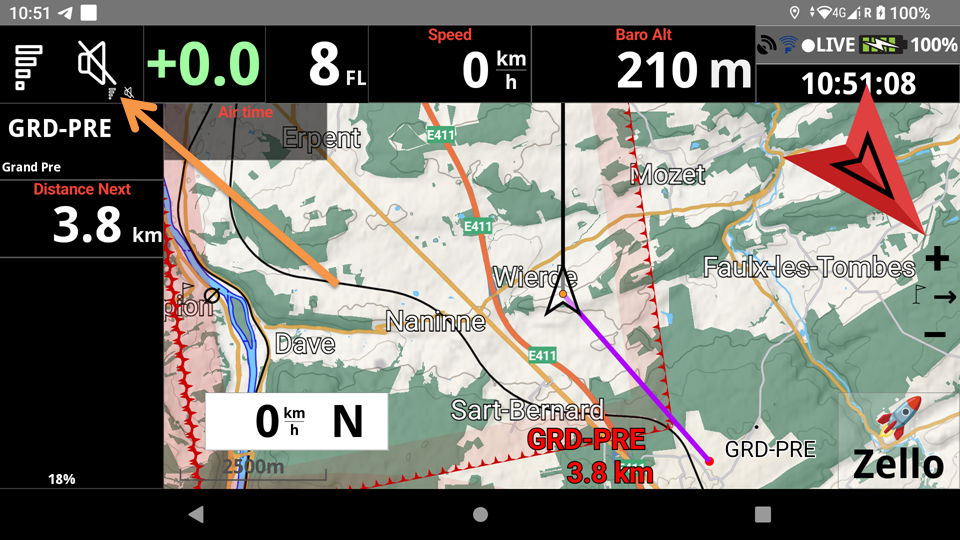
Click the Sound Config button to adjust your lift and vario sounds.
You can select your preferred sound type and choose whether to use the vario based on pressure sensor data, the lift detection based on accelerometers, or a combination of both.
You can also adjust the volume, thresholds and averaging intervals.
If you are using Zello, you can reduce the volume of the vario sound while speaking through Zello.
The initial averaging interval determines the initial vario sound based on pressure data. Increasing this value too much will generate more lag before the first vario sound is heard. The following averaging interval allows you to adjust the vertical speed noise just before the next vario sound. Therefore, this value can be higher without generating more lag.
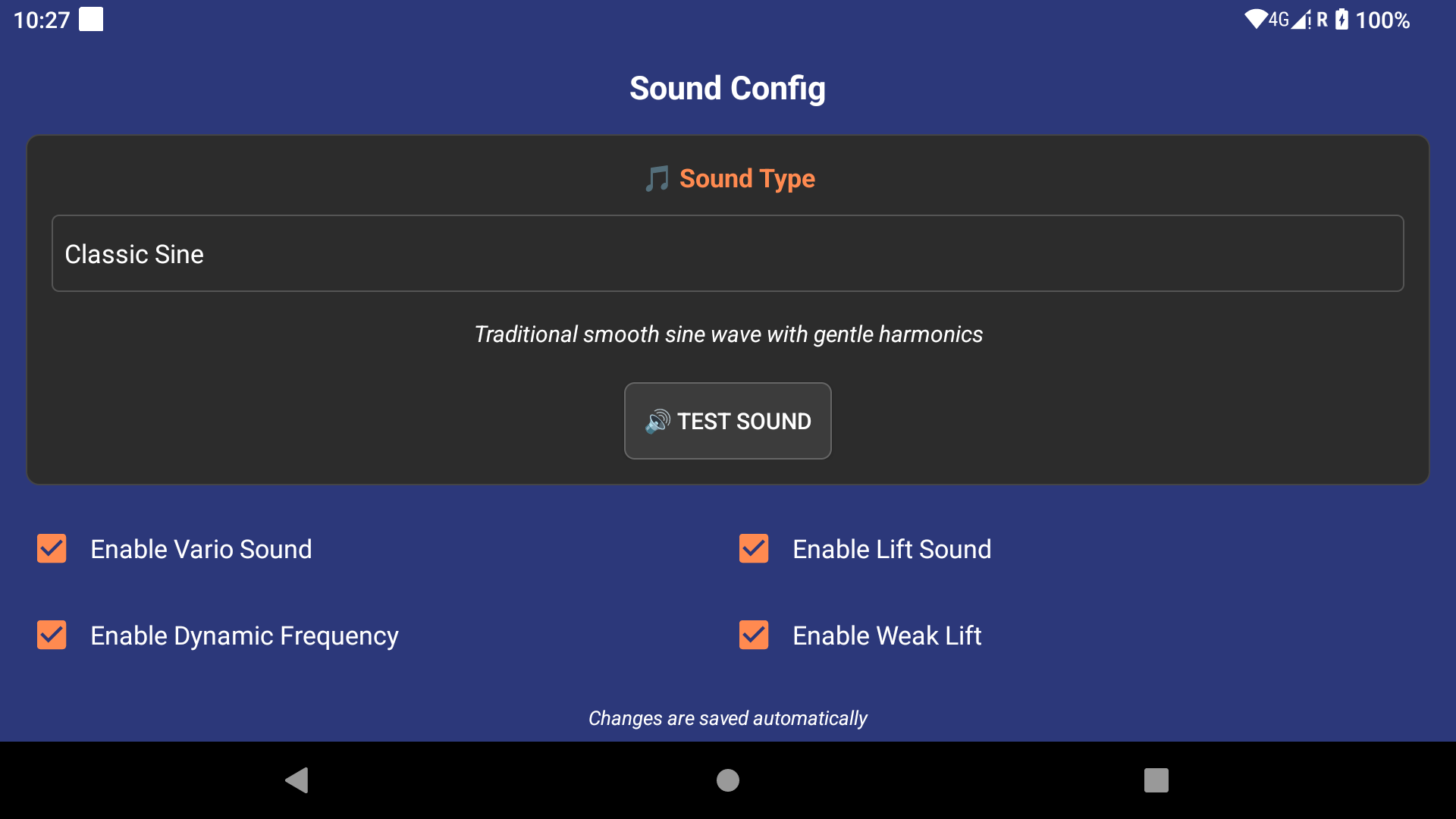
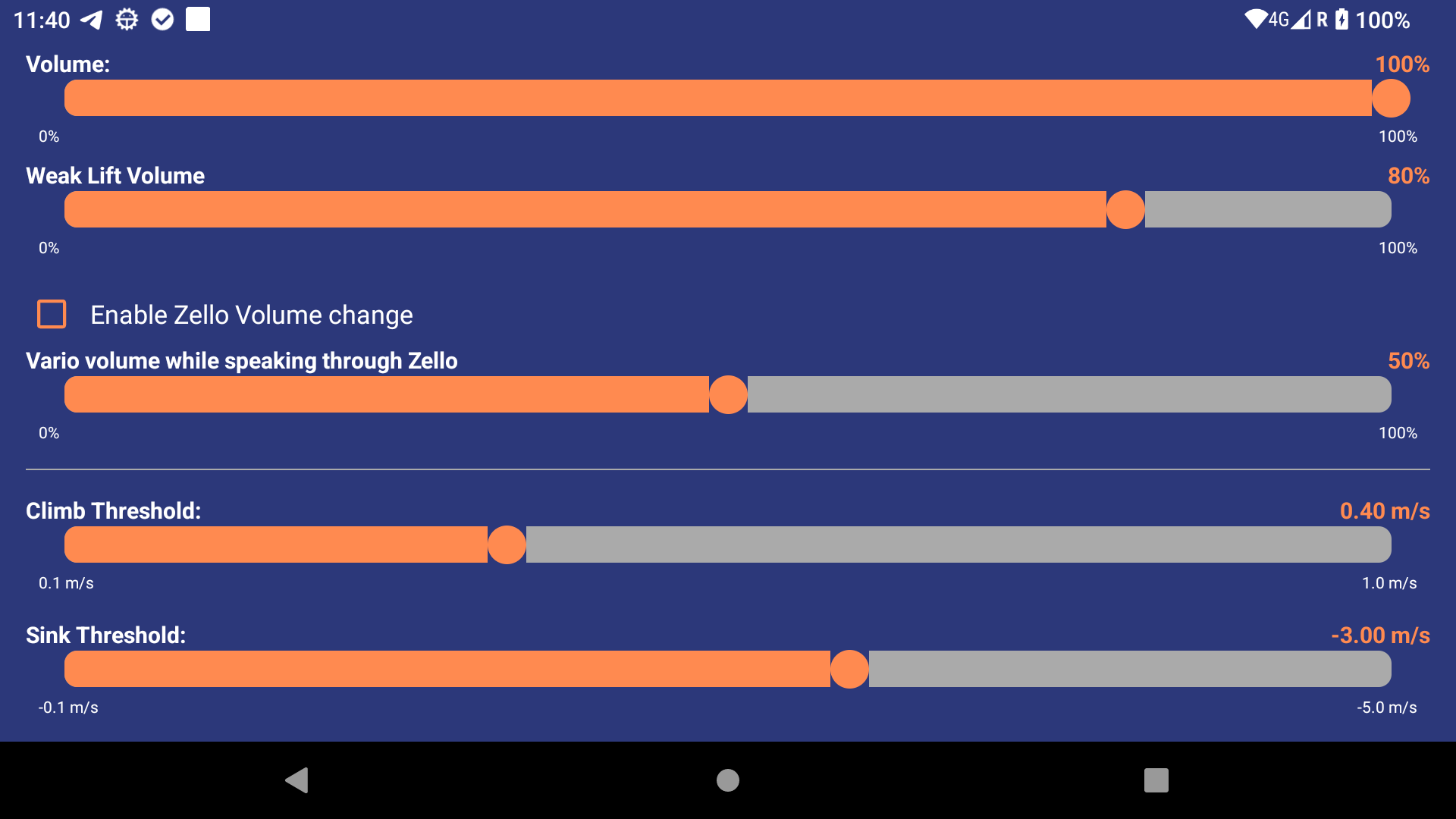
By scrolling down, you can use a cursor to simulate the vertical speed, enabling you to hear what you would hear during a real flight.
The sound configuration table enables you to adjust the frequency, cycle duration and duty for each vertical speed step. If you have a custom sound file generated by XCTrack, you can import it by clicking the ‘Import custom sound (.xcvsp)’ button.

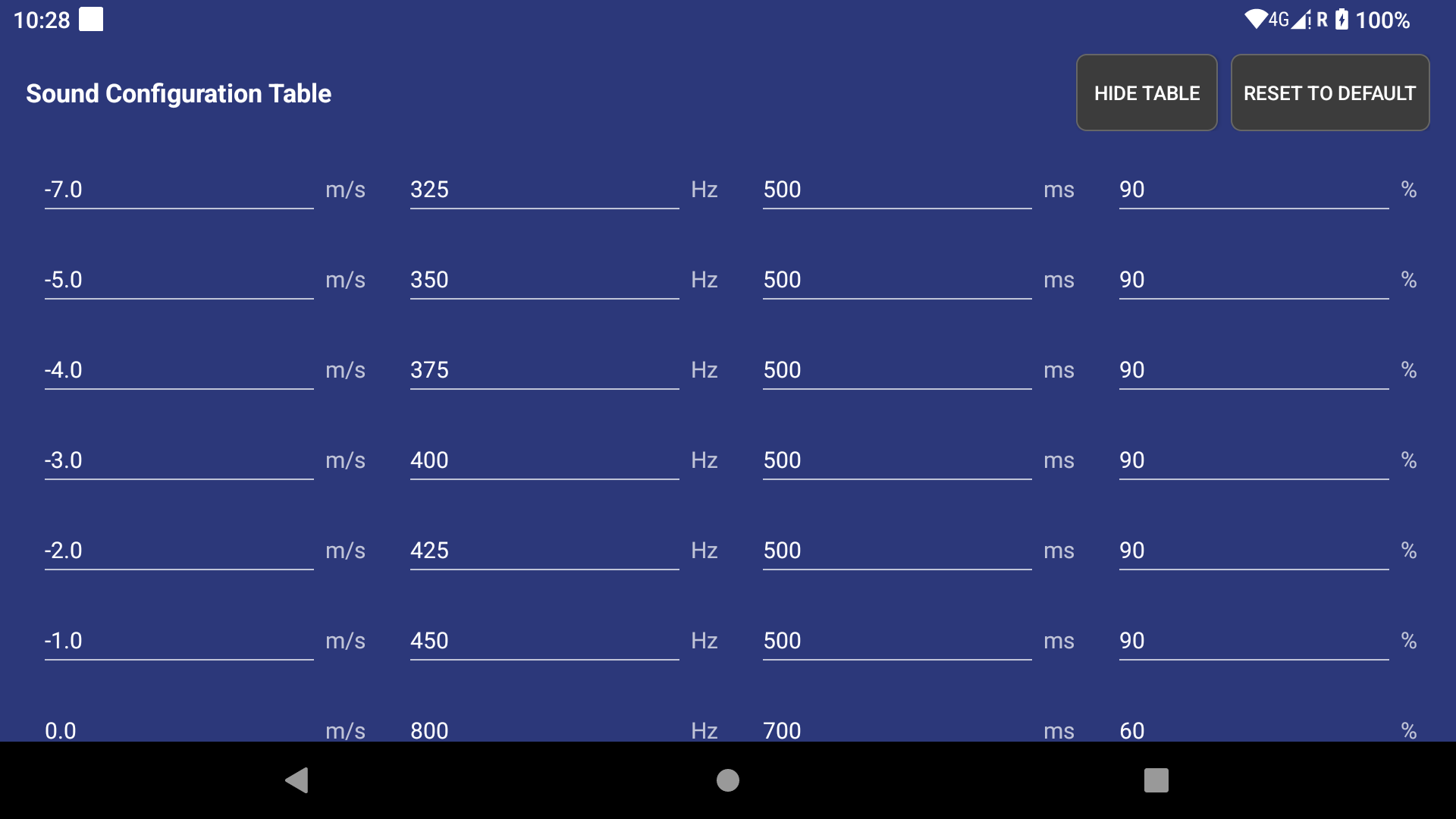
You have the opportunity to select your preferred sound type. Depending on your selection, you will be able to enable dynamic frequency or not. Dynamic frequency provides additional acoustic information relating to changes in vertical speed. Some sound types cannot enable dynamic frequency, some allow you to choose whether to enable it or not, and the Triplet sound type can only work with dynamic frequency.

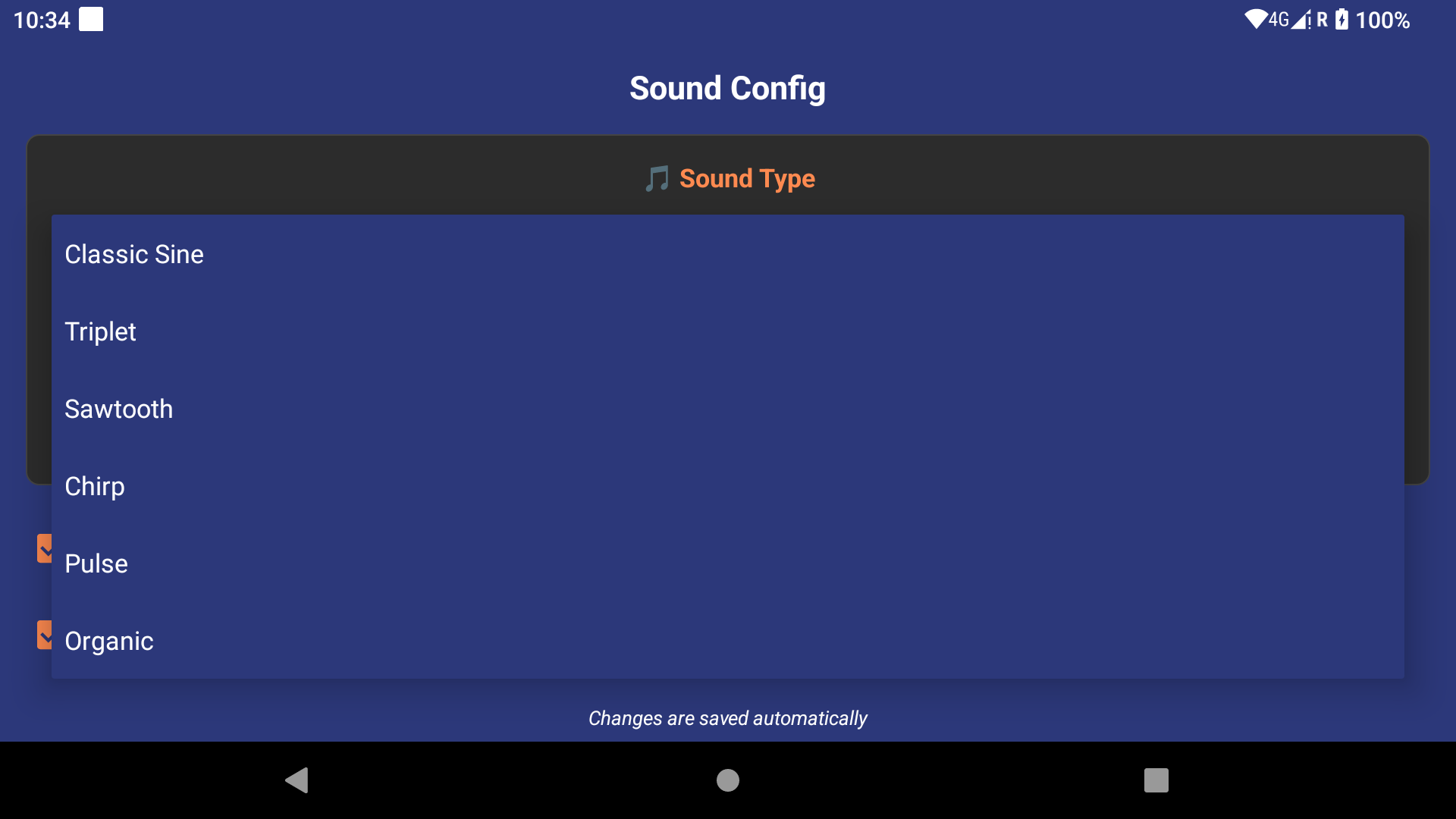
Enabling Weaklift causes the acoustic variometer to emit three beeps while your vertical speed remains between the Weak Lift Low Threshold and the Climb Threshold. This indicates that the air is rising slightly. If your altitude is not changing (i.e. the lift is strong enough to compensate for your negative vertical speed), you will hear three beeps at the same frequency. If your altitude is decreasing (the lift is not strong enough to compensate for your negative vertical speed), you will hear two beeps at the same frequency and a third beep at a lower frequency. If your altitude increases (the lift is stronger, compensating for more than your negative vertical speed), you will hear two beeps at the same frequency and a third beep at a higher frequency. As soon as strong acceleration is perceived, Weaklift will stop and the Lift Beep will take over instantly, most probably followed by the Vario Beeps.
You can set a different volume for the weak lift beeps.
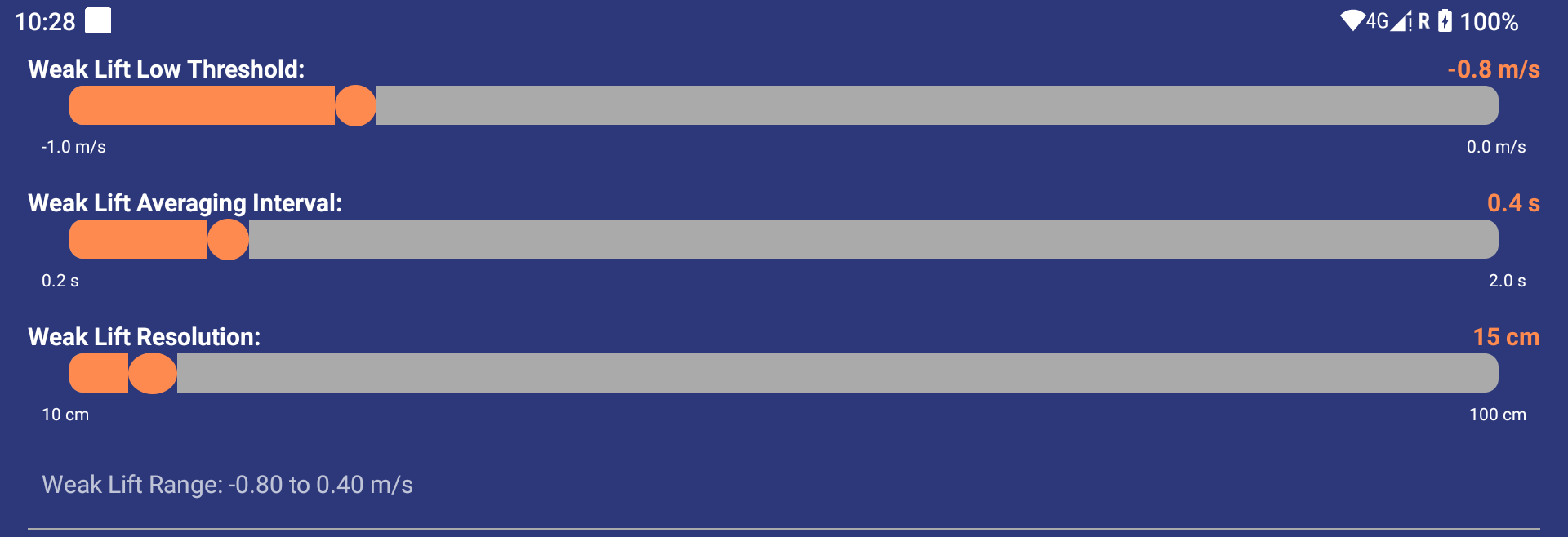
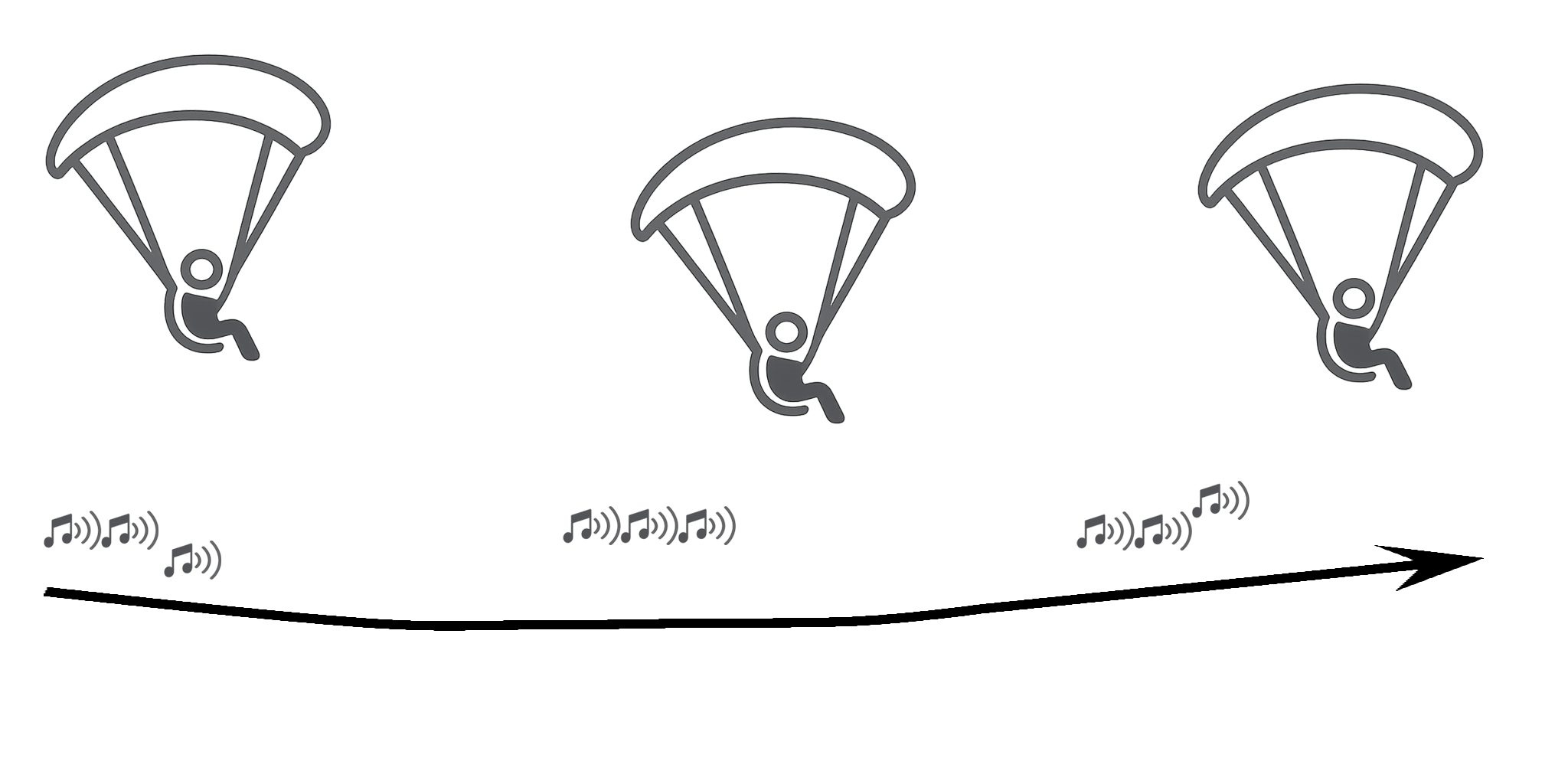
Click the ‘Instant Lift Detection Config’ button to configure the lift detection settings.
To change the sensitivity of the detection, set the slider to one of the five positions and click Apply.
You can also select whether to use the default ideal IMU values or custom values based on the calibration data. Unless you are experiencing a specific issue with the accelerometers, it is not recommended to use specific calibration data.
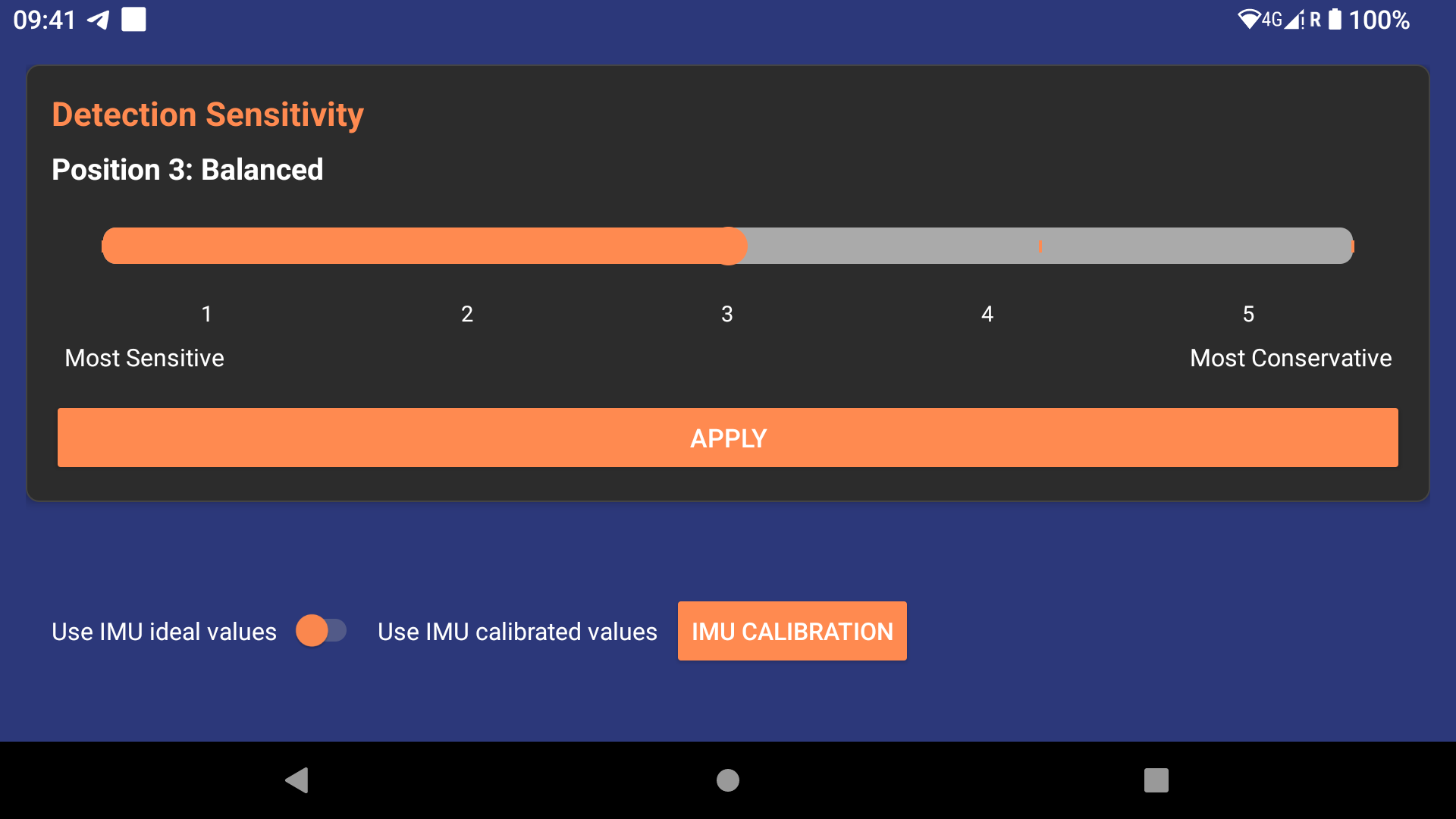
Custom sound for flight events
By default, without any specific configuration, you can combine an existing XCTrack event with a sound.
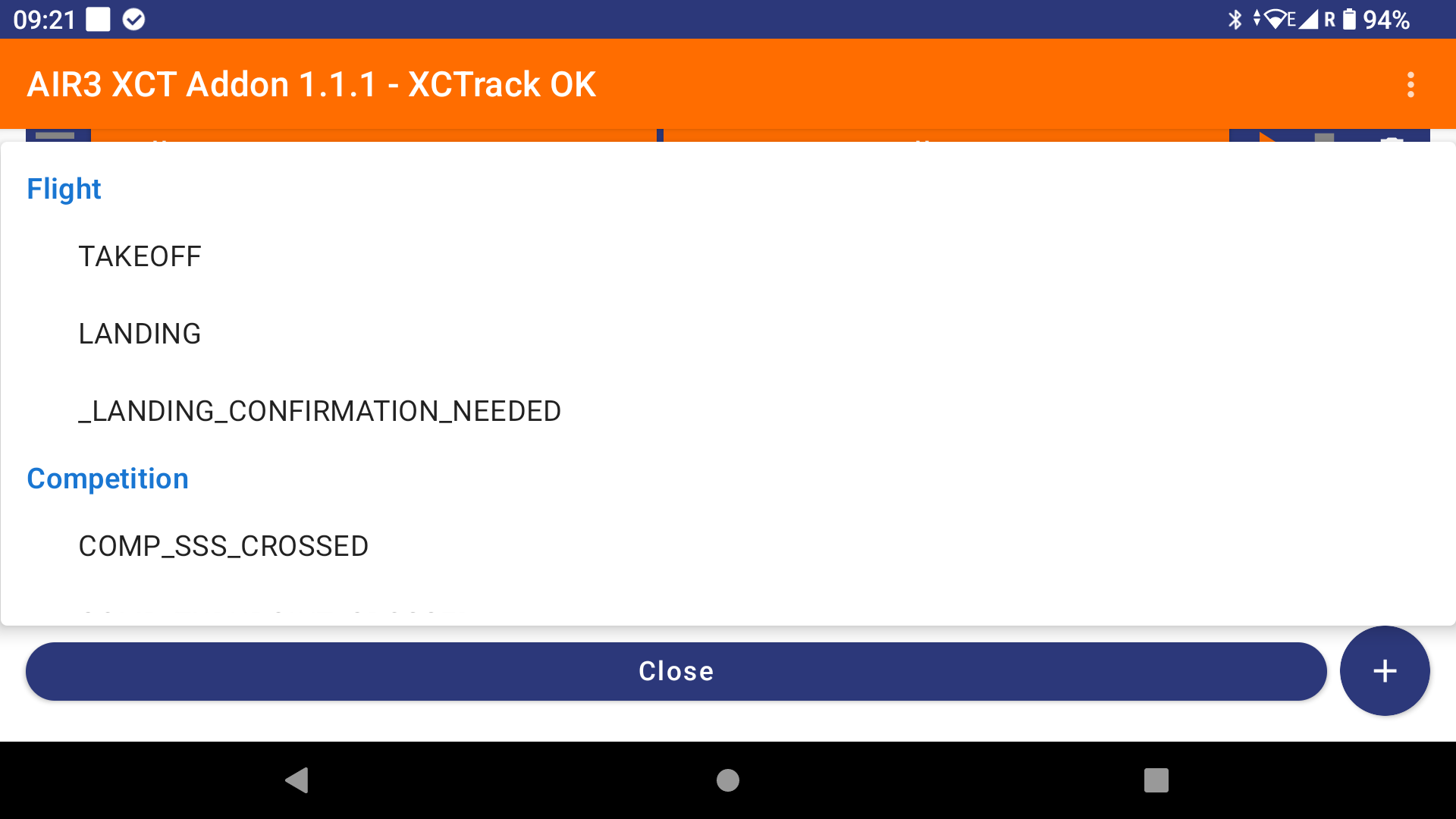

You can use either the existing sound files or your own. If you want to use your own sound, add the file to the AIR³ XCT Addon sounds folder.
Once selected, you can adjust the volume and specify how many times the sound should play.
Click on the triangle to play the sound.
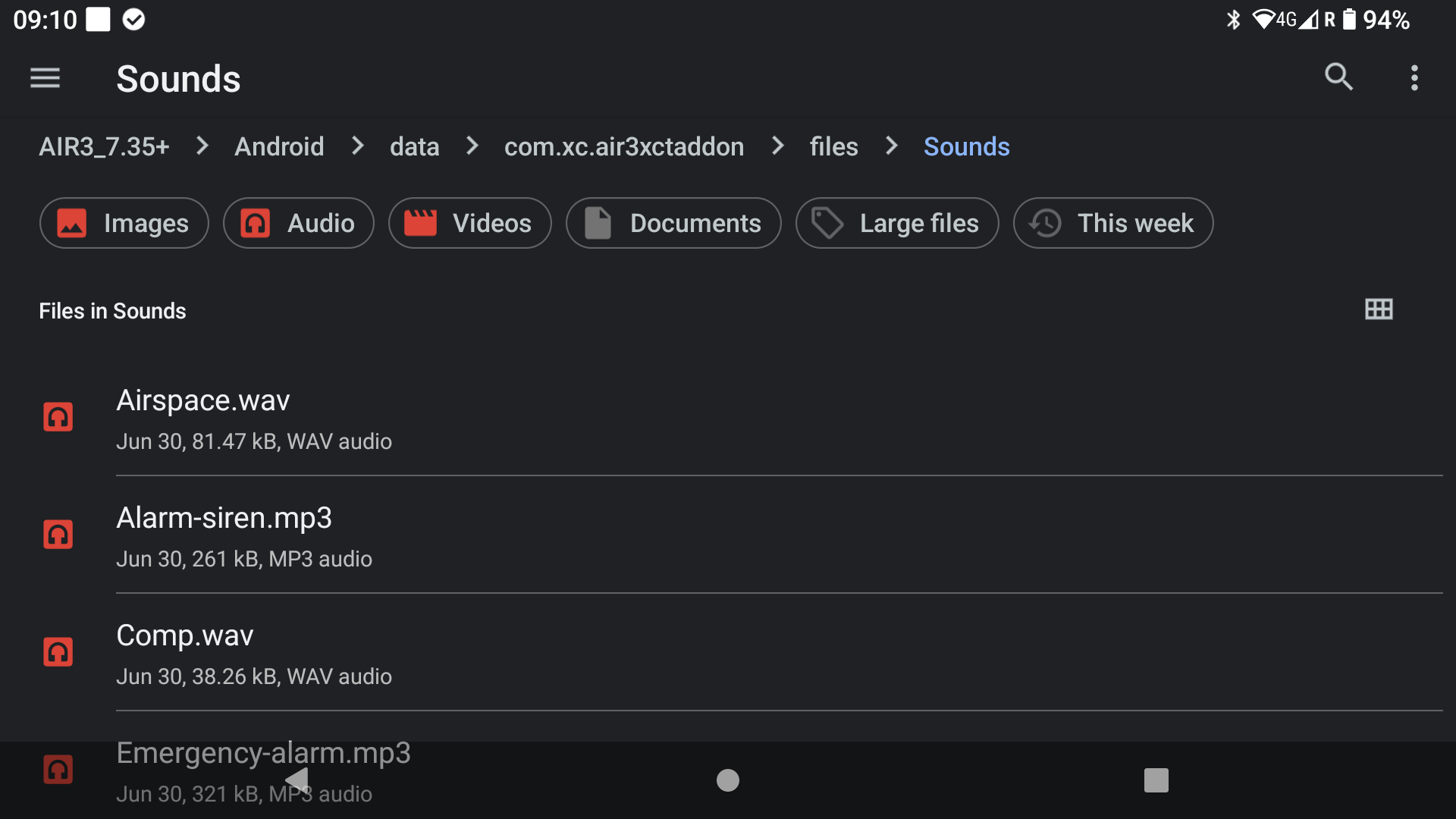
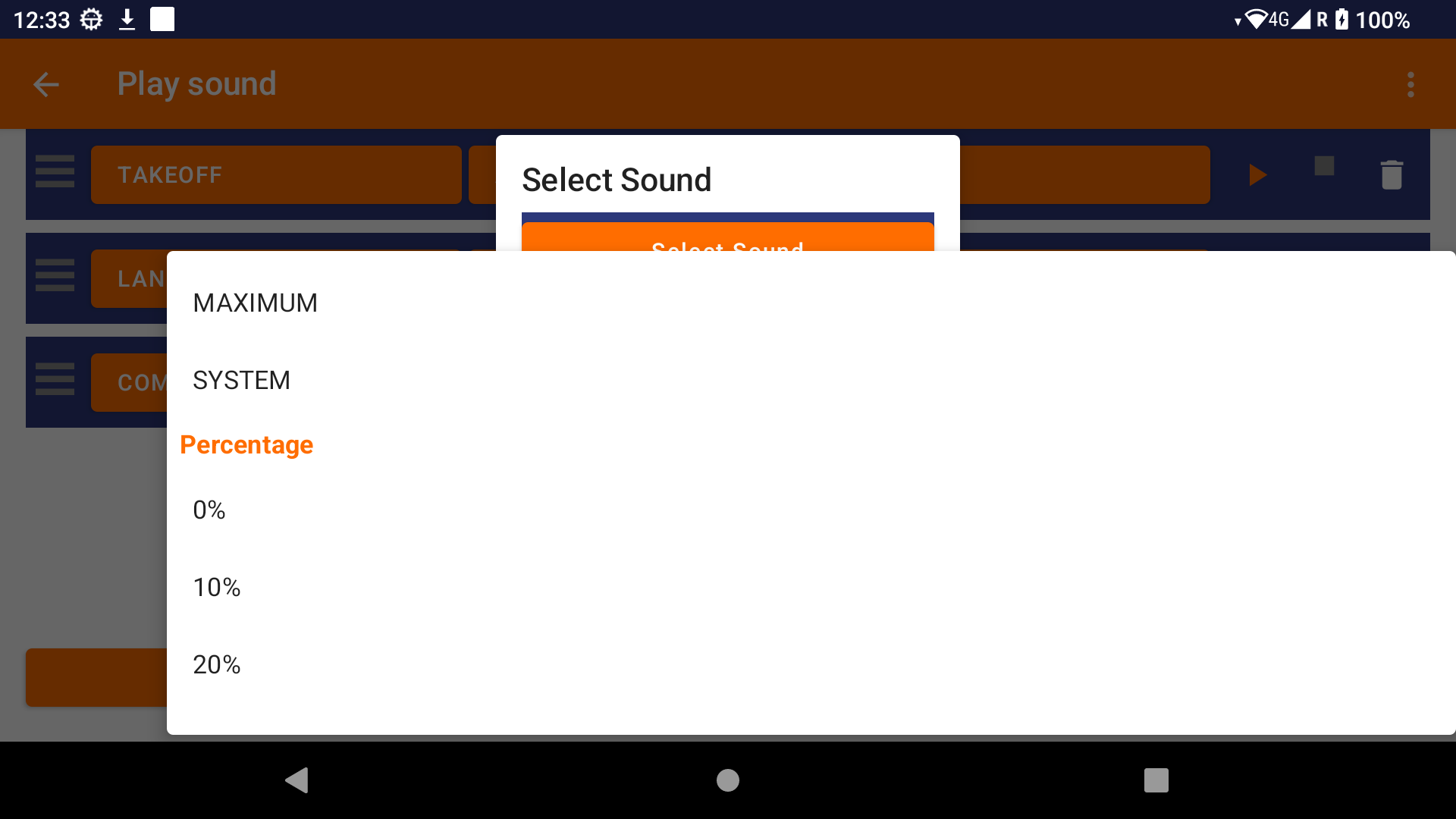
XCTrack Intent launcher widget
XCTrack already contains a lot of predefined events.
Within XCTrack, you can also add a new widget based on “Intent launcher” widget to add a new event to XCTrack events list.
Name it using “\n” if you want to display the different words on mulitple lines.
In the Action section, add the name of the custom event you want to use without any space or special character. Pay attention to the case.
As described here below, Zello PTT is one of the possible use of these “custom” widgets. You can use AIR³ Manager with the Expert-zello profile to directly configure the expert profile with Zello widgets.
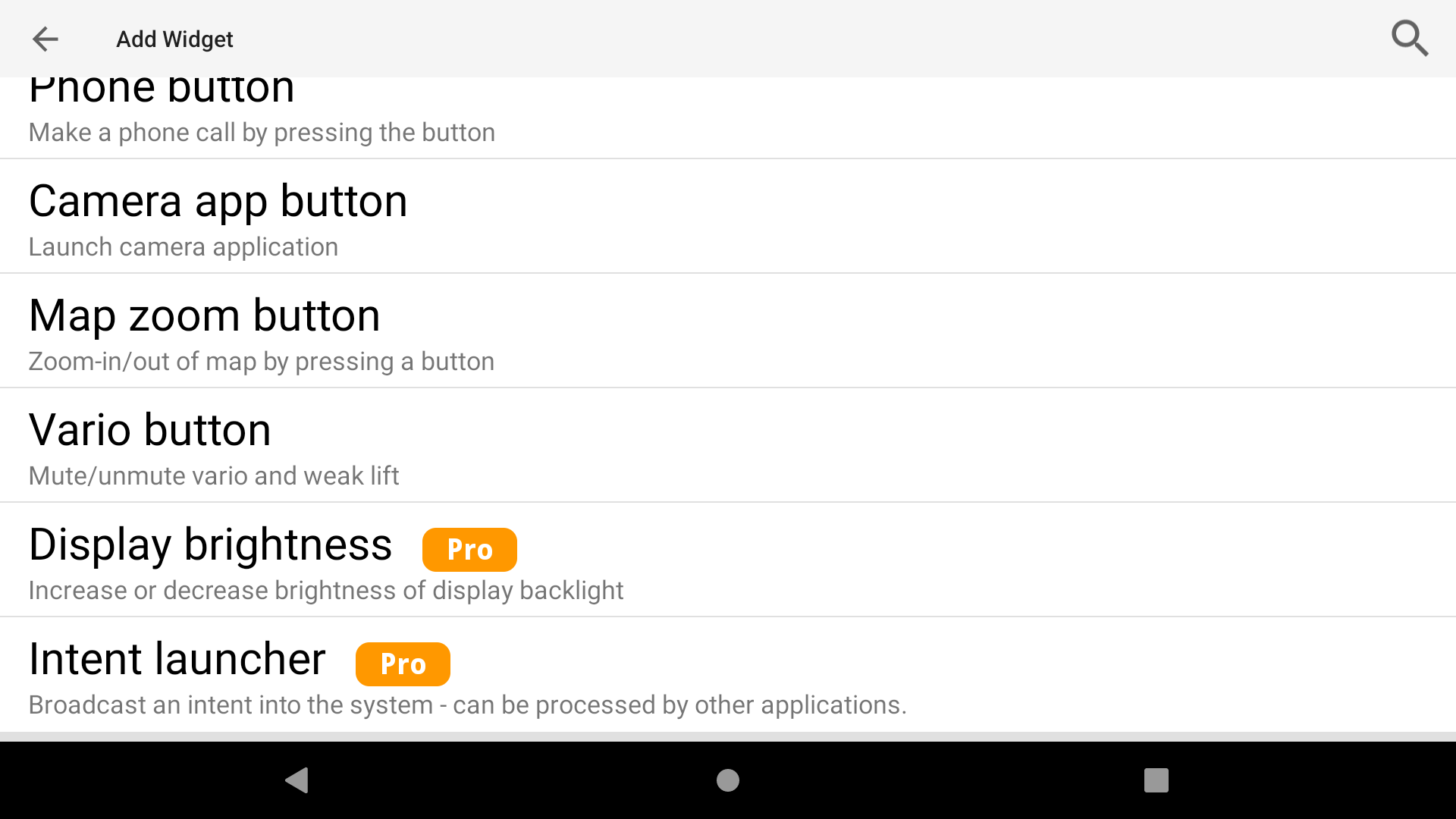
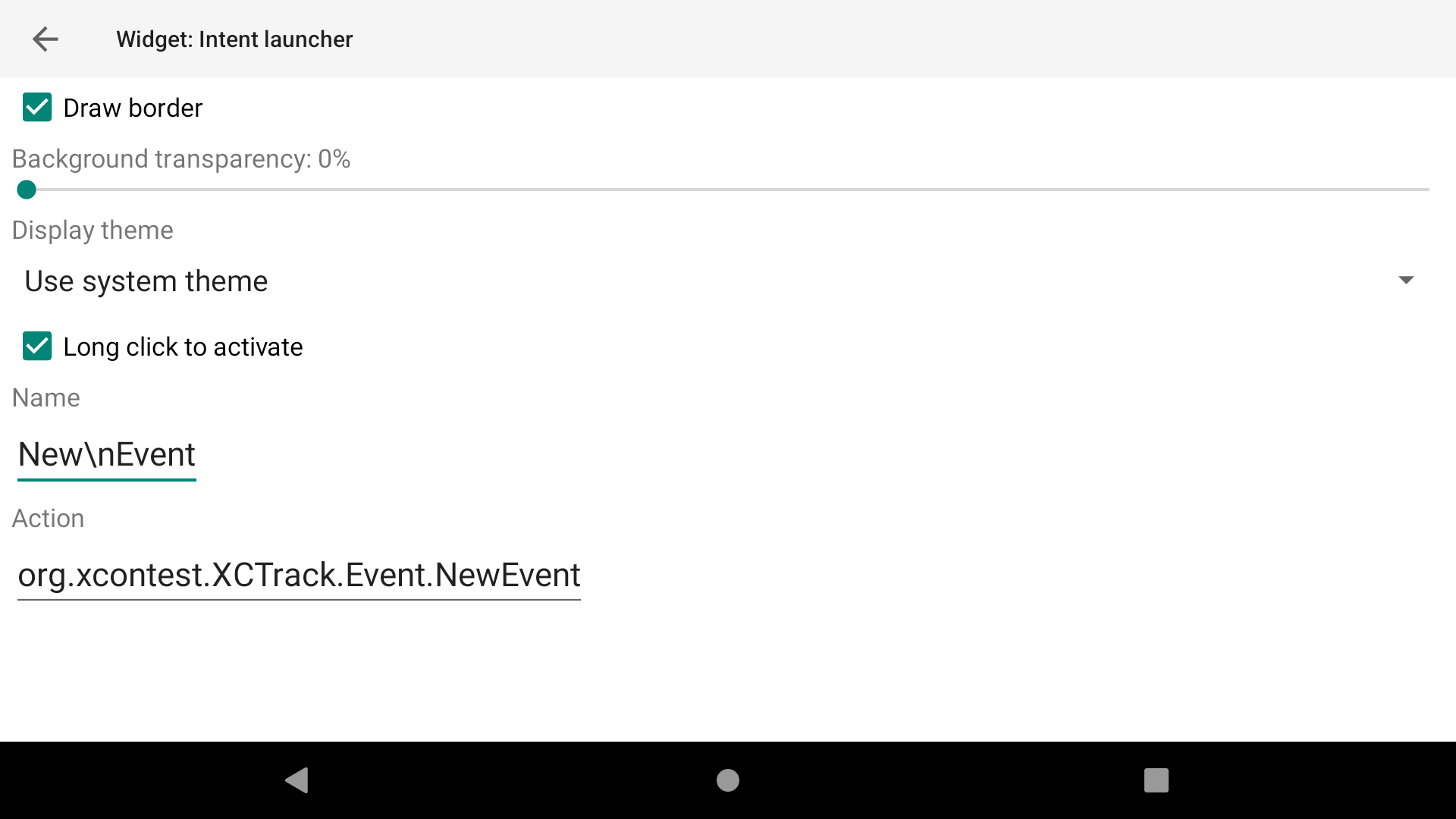
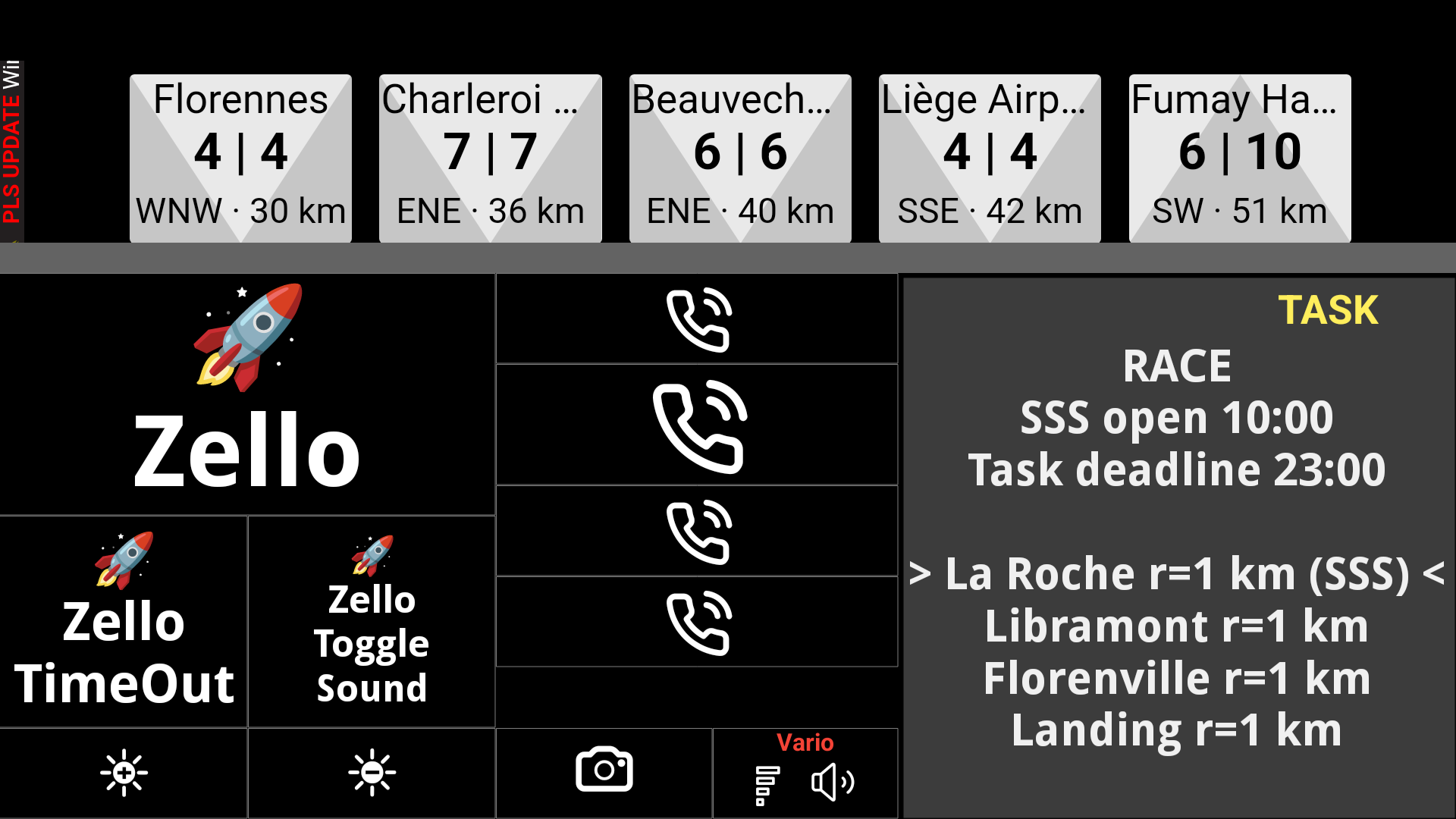
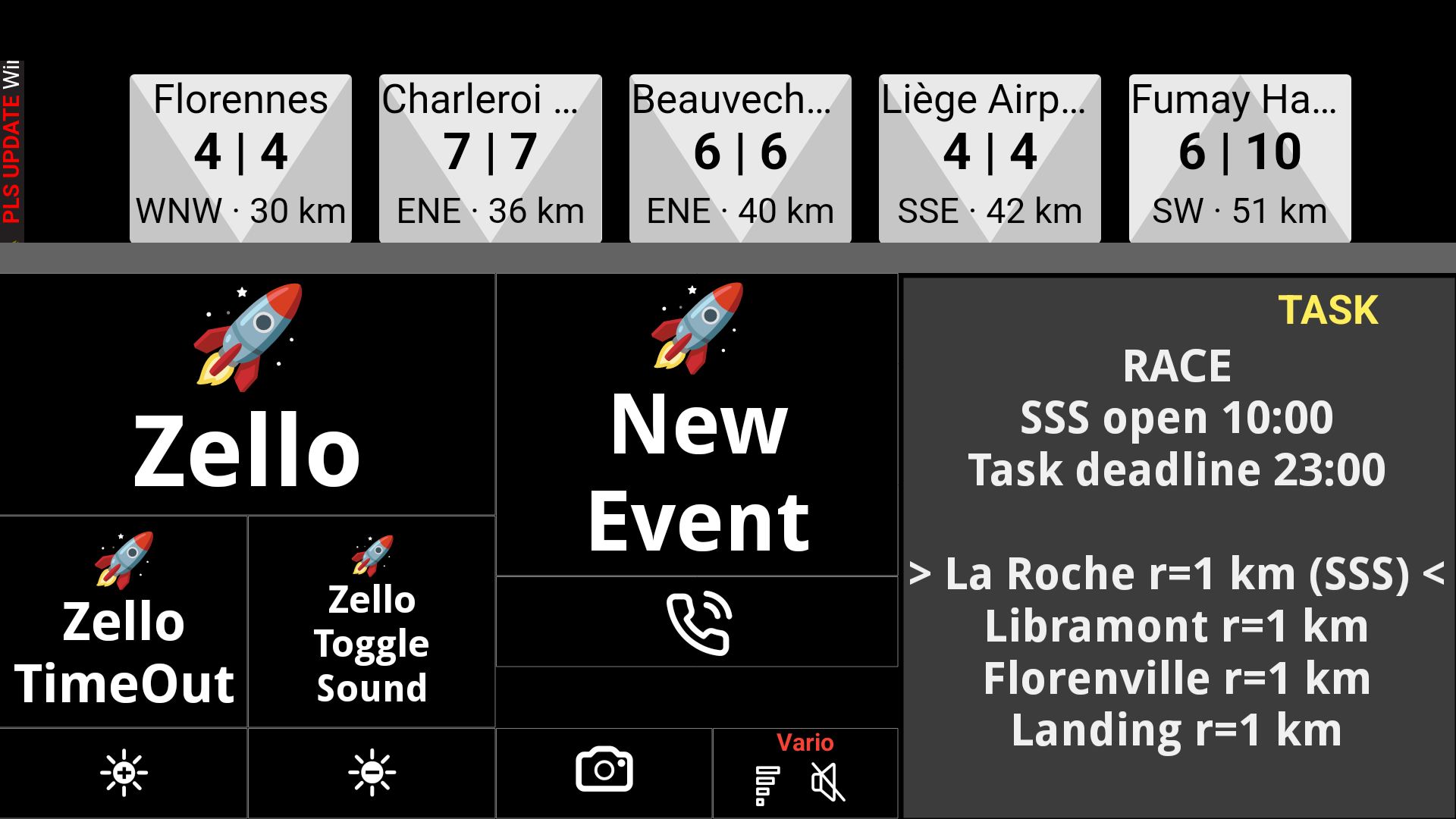
Add a new custom trigger event
Within AIR³ XCT Addon, go to settings and click on “Add a new trigger event”, then “Add new XCTrack event”. Select the category to sort the event easily and type the event that you have set in the XCTrack custom widget. After confirming, the new event will be monitored by AIR³ XCT Addon if you select it in a combination row.
If your goal is to use Zello PTT, see below how Zello events can be automatically generated within Zello configuration (you don’t need to create these XCTrack events within AIR³ XCT Addon).
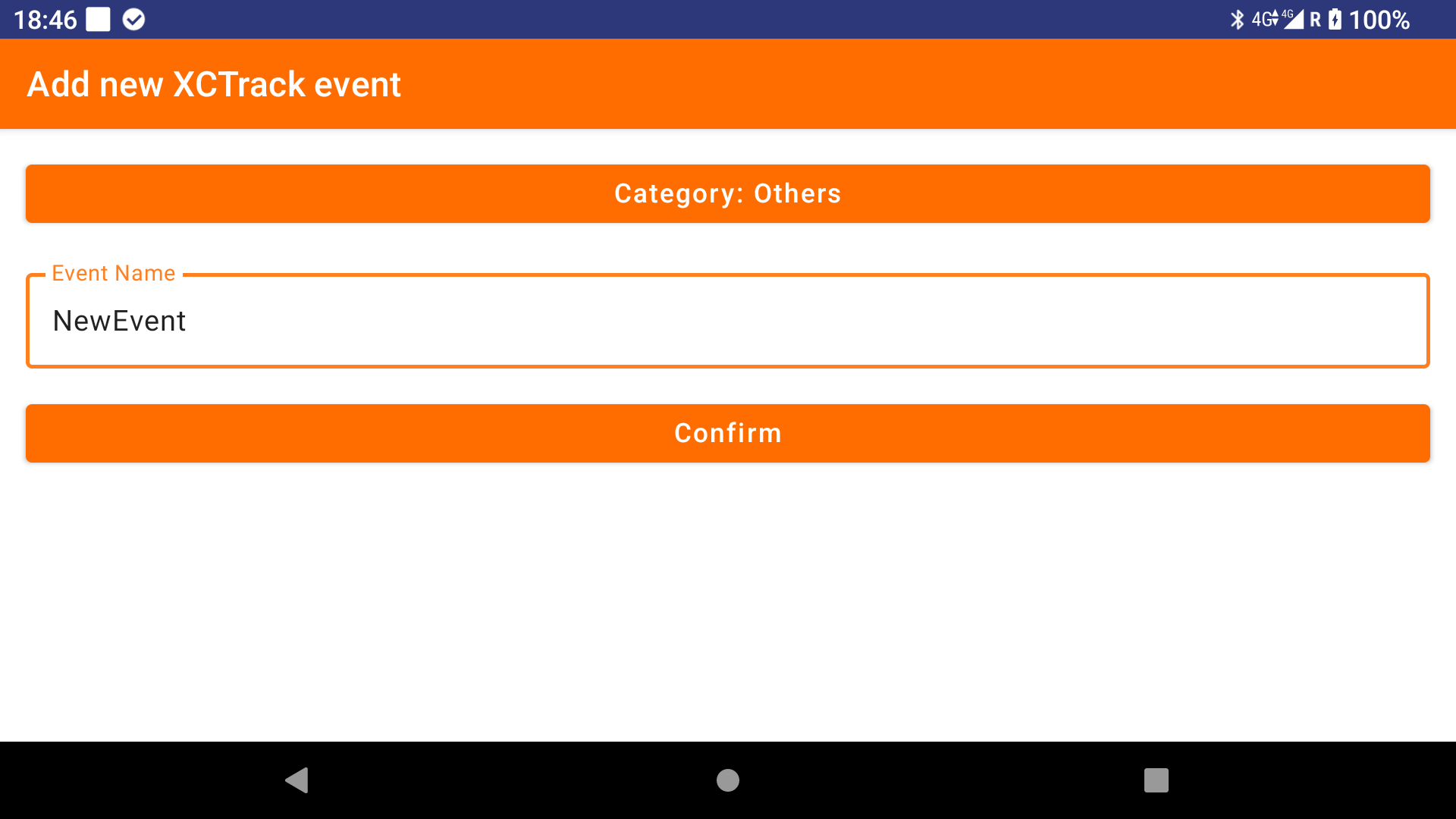
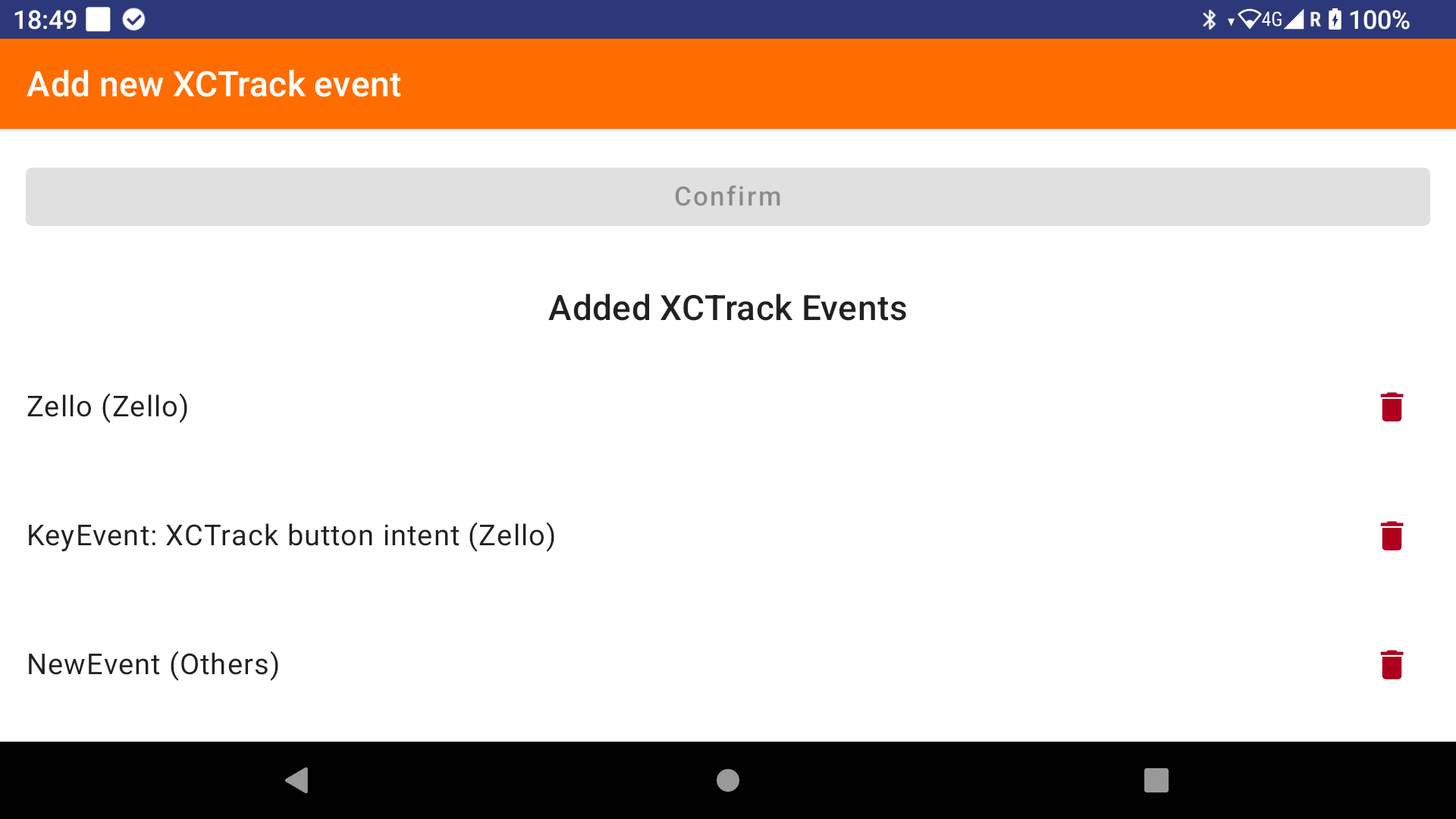
Launch an App
In the Settings menu, click the ‘Launch an app’ button. For example, you may want to launch an app in the foreground or background when taking off or when clicking on a specific XCTrack widget.
Then create a new combination row, select your new XCTrack trigger event and combine it with the task you have created.
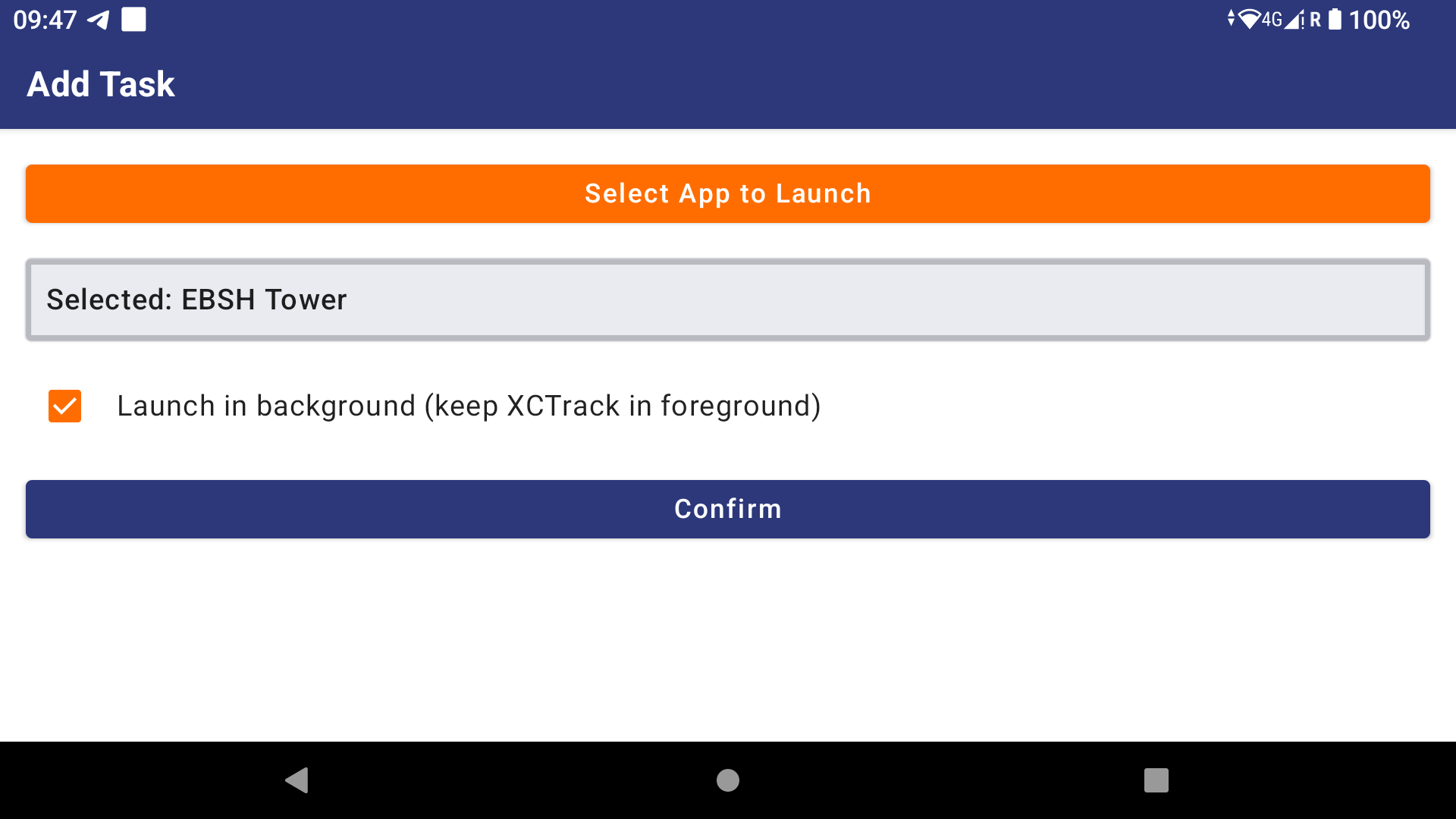
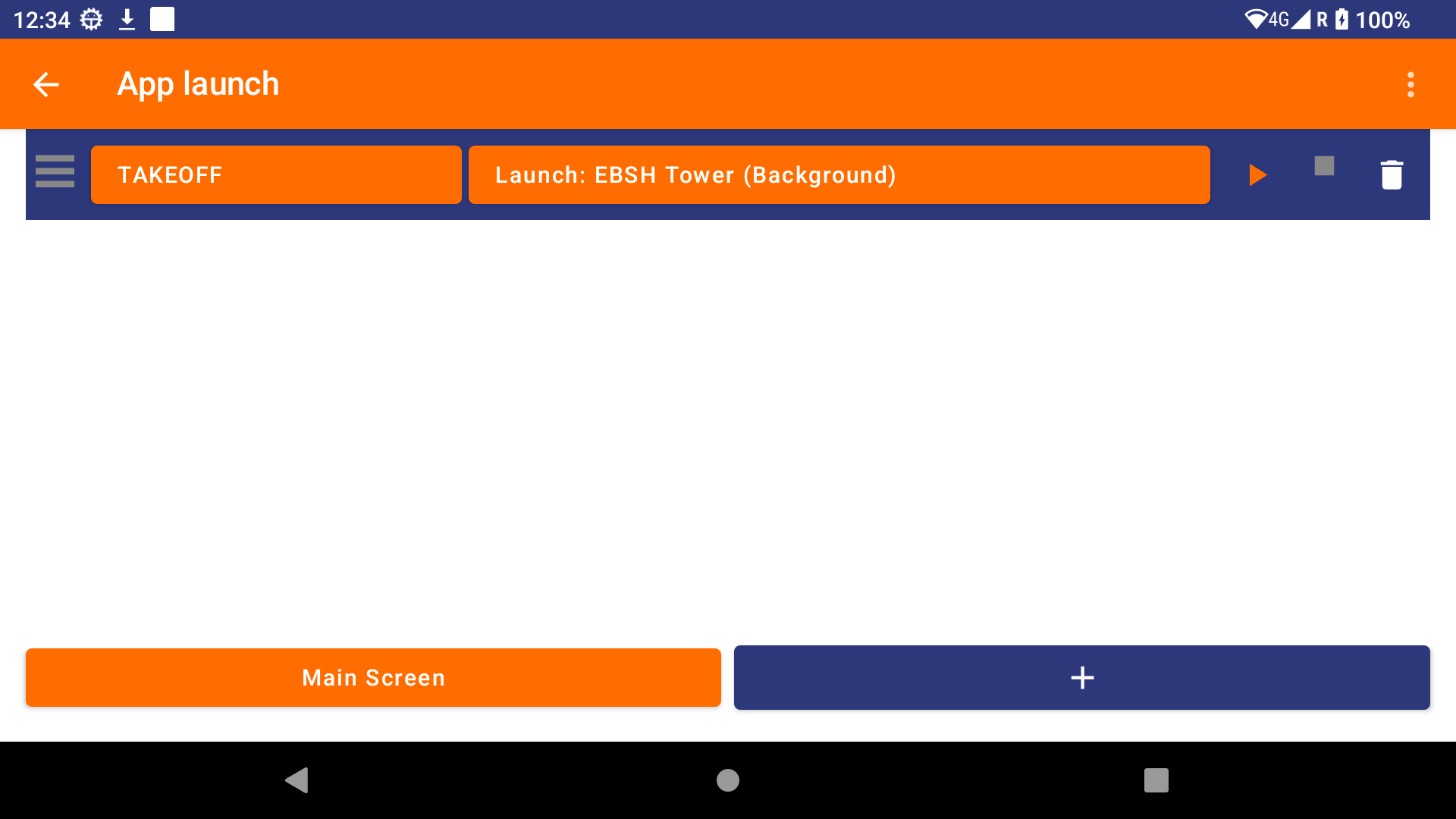
Zello configuration
Zello is a convenient way to communicate with others, similar to radio communication, except it is internet-based.
With AIR³ XCT Addon, you can communicate through Zello using either a XCTrack widget or a button (physical or with a Bluetooth remote control).
Once you have installed Zello and created a Zello account, test first your Zello setup before configuring XCTrack and AIR³ XCT Addon for Zello.
IMPORTANT NOTE: You need to set Zello’s battery optimisation to ‘Unrestricted’ so that it keeps running in the background and can receive communications sent by XCTrack through the AIR³ XCT add-on.
Go to Settings > Apps > Zello > Battery to check this.
To communicate with Zello, you need to have defined the channel or the person you want to talk to. Set it as default to automatically load Zello with this conversation and not forget to start the communication channel you want to talk to.
Once Zello has been set up, go to Settings and click on the Zello Configuration button.
Enabling Zello creates two new combination rows: one triggered by clicking an XCTrack widget (based on an XCTrack intent launcher widget configured with ‘Zello’ as the event name), and one triggered by an XCTrack button intent (based on a hardware button click caught by XCTrack and configured in the key bindings/launch Android intent). Both triggers are combined with the Zello PTT feature.
Select the Expert-Zello profile in AIR³ Manager to automatically generate Zello-related custom widgets.
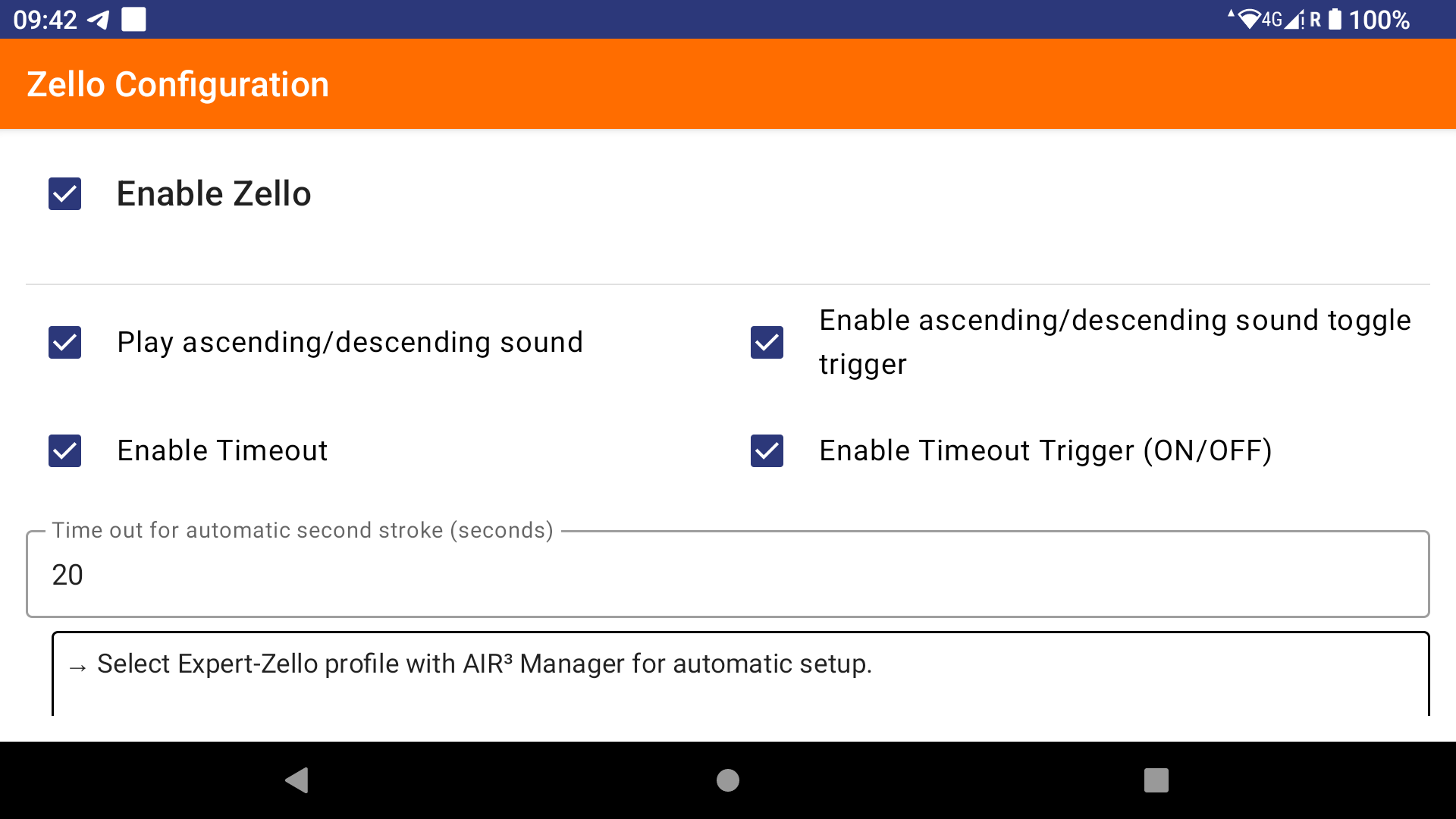
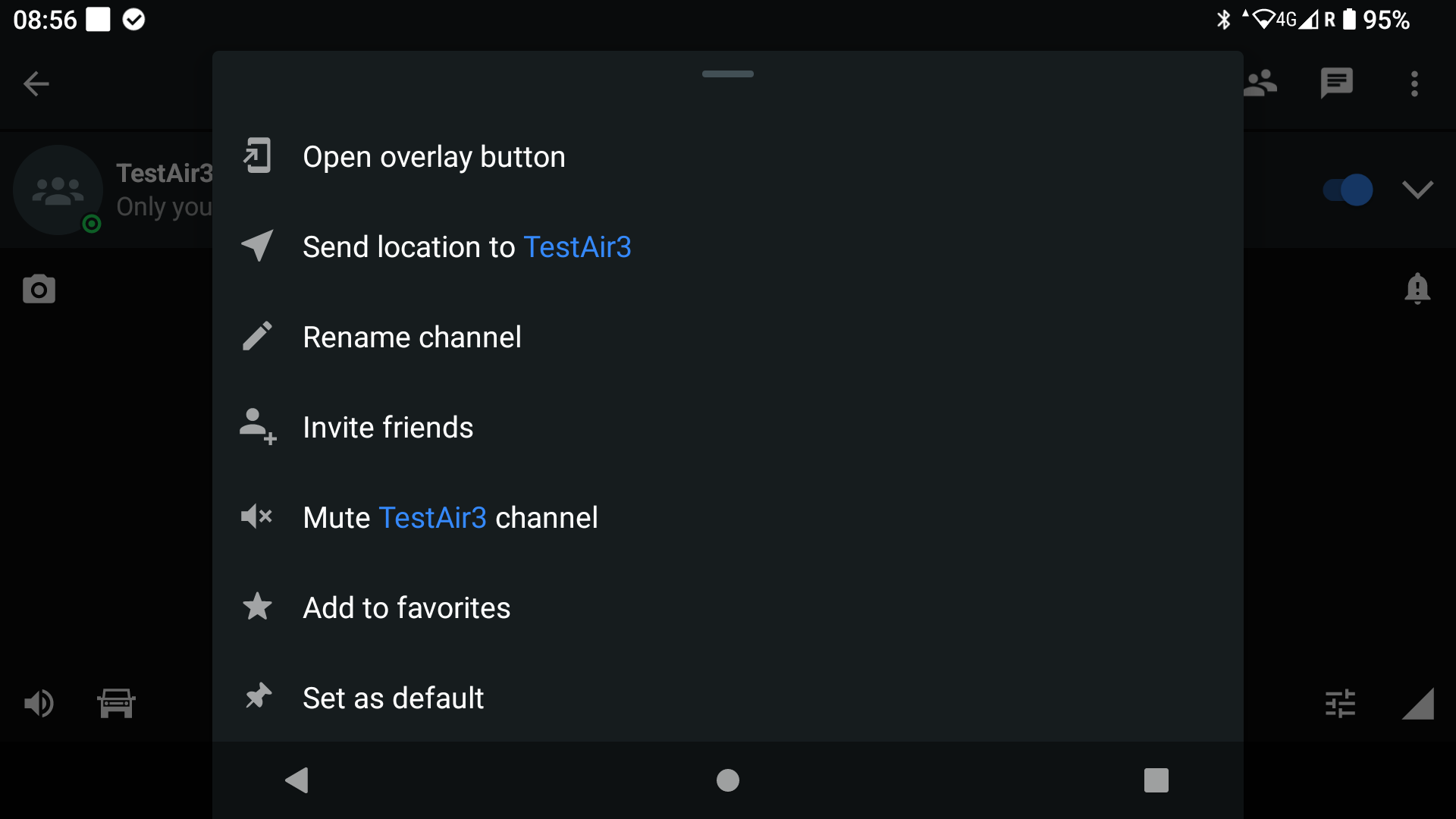
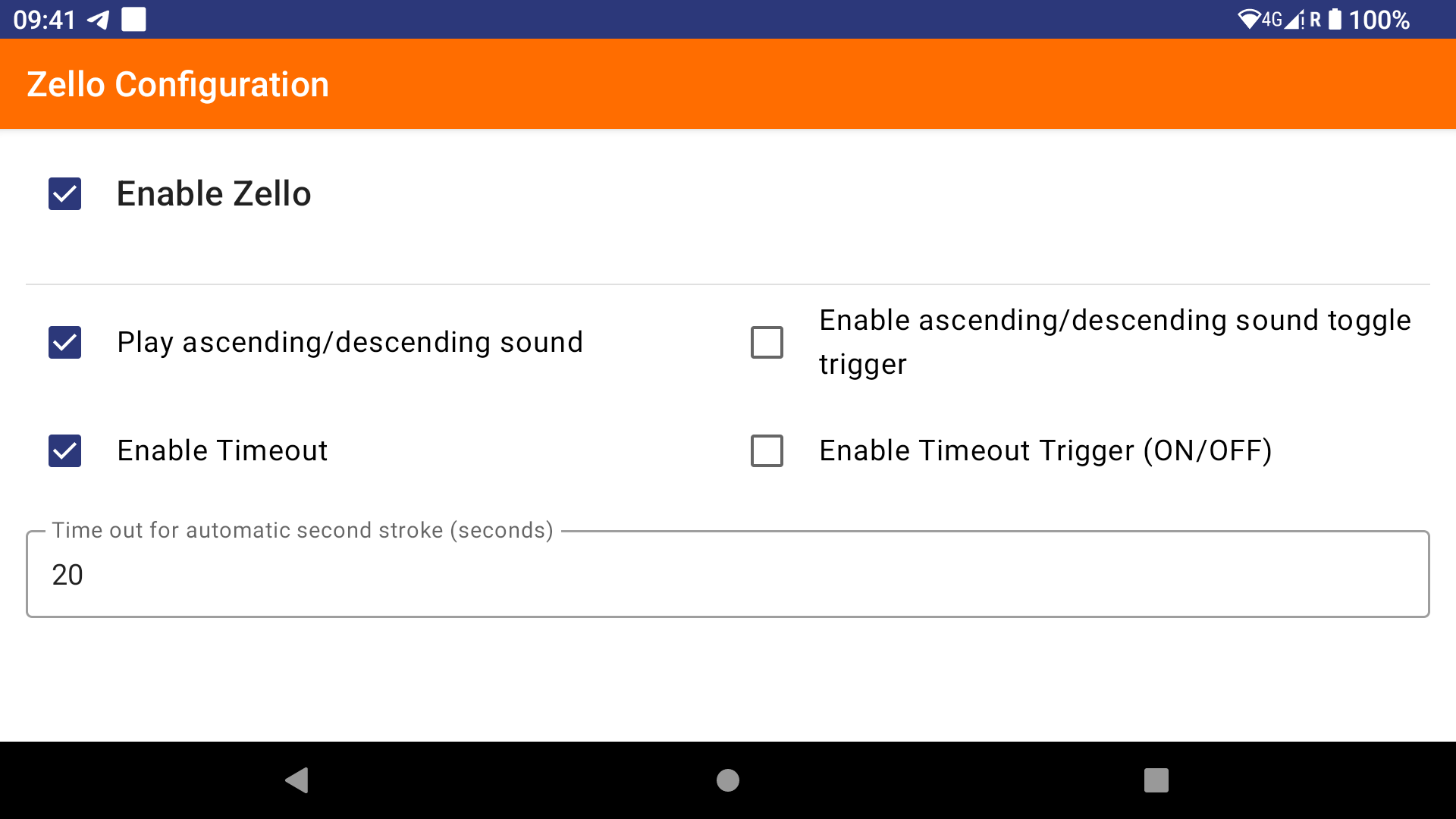

If you want to be able to use Zello through a BT button in addition or instead of a widget, in XCTrack Preferences/Key bindings, select Launch android intent. Click on the physical button you want to use.
XCTrack will catch this button event and will share it with AIR³ XCT addon.


Clicking on the play button in the combination row will send an initial call to Zello.
At this stage, Zello should not work.
Then, go to Zello Options. Click on Settings, then Push to Talk buttons.
A new button called ‘Hardware button’ should now be visible (created by clicking on the play button in the combination row with Zello PTT defined as the task).
Click on the ‘Hardware button’. Change the ‘Push to talk’ button action from ‘Hold to talk’ to ‘Toggle’.
You can now go back to the AIR³ XCT add-on and test the play button again. This time, you should hear the ascending sound indicating the start of your message, and clicking a second time should produce the descending sound indicating the end of your message.
If you do not click a second time within the timeout delay, the app will do it for you.
Note that you can also enable or disable the timeout through a special widget, as defined in the Expert-Zello profile of AIR³ Manager.
Once this is working through the play button in the AIR³ XCT add-on, you can test it directly in XCTrack, either with the Zello widget or the button you have defined.


Thanks to the AIR³ Manager settings, make sure to automatically launch the AIR³ XCT Add-On and Zello on boot, so that everything will work smoothly every time the unit is started.

It is possible to use a Bluetooth headset with Zello while still using the AIR³ speakers for audio output.
Once your Bluetooth headset is connected, go to Android Settings > Sound & vibration on your AIR³, click on ‘Play AIR³ XCT Add-on’ and select ‘This phone’.
Then open Zello and select the group you want to use. In the bottom left corner, click on ‘Audio device’ and select ‘Bluetooth’.
When talking through Zello, it is recommended that you turn off the Vario sound temporarily to avoid interference.


Telegram configuration
In order to use the telegram tasks (Send your position, send a message to a telegram group, safe landing reporting through Telegram message and position), the pilot name must be filled in. Once you have added your pilot name, you will have the opportunity to proceed with the Telegram authentication. Follow the steps and send /start to the Telegram bot to finish the authentication.




Once done, you can add a new task with Telegram.
Click on Configure Messages to add or modify a message to send through telegram.
Click on Send Position to telegram to configure a task to send your position to a specific Telegram Group.
Click on Send message to Telegram to configure a task to send a specific message to a specific Telegram Group.
Click on Send message & position – Safe Landing to configure a task to send a telegram message and your position to a specific Telegram Group if you do not validate a safe landing reporting upon landing.

To send your location to a Telegram group, click on ‘Send position to Telegram’.
Then click on ‘Select a chat’. If you have previously added a group, select the available group. Otherwise, click on ‘Other’.


You will then be prompted to add the bot to the group, provided that the group has just been created and the bot has not yet joined.
To add the bot to a group, you need to be an admin of that group. Select that group’s chat and click on the “v” to add the bot.




Once you return to the app, click on “Refresh Chat List” button, then on Select a chat, the new group will be selectable.

If the group already contains the bot, click on ‘Select group with bot’. Select the chat of the group that already contains the bot. Click on ‘/’ in the message tools, then click on the send button.
Once you return to the app, click on “Refresh Chat List” button, then on Select a chat, the new group will be selectable.


These tasks are now available in the combination row selection.
To send a message to a group on Telegram, you can use the same method as for sending your location, but you will create the message during the process.
See below the specific configuration for Safe Landing Reporting configuration.


Once you have selected the group, click on ‘Add/Select message to send’ to set up your message.
Type the title and content of your message, or select a saved message.
Once you have finished, click the ‘Select Message’ button.


To send a message and your position to a group on Telegram if you do not confirm a safe landing, you can use the same method as for sending your location or sending a message.
Once you have selected the Telegram group, click on the ‘Safe Landing Reporting’ button to configure how the prompt will behave and how you will be reminded.


If configured correctly, a task with the Safe Landing Reporting option will work as follows:
- Upon landing, a window will automatically open with the message: ‘Did you land safe? Click here”.
- If the pilot clicks on the window before the “DO NOT SEND” timeout ends, the Telegram message will not be sent to the selected Telegram group.
- If the pilot does not click on the window before the ‘Play reminder after’ timeout, the reminder sound will play according to the sound settings (volume, count).


Once you have configured the Safe Landing Reporting task, don’t forget to create a combination row that links the Landing XCTrack event to this newly created task.
As you can imagine, this security feature will only work if the device is correctly configured and has internet access when attempting to send the message.
Test it using the play button in the combination row and/or by simulating a flight with XCTrack.



Once you have set your tasks, you can manage them under “Configured tasks”

